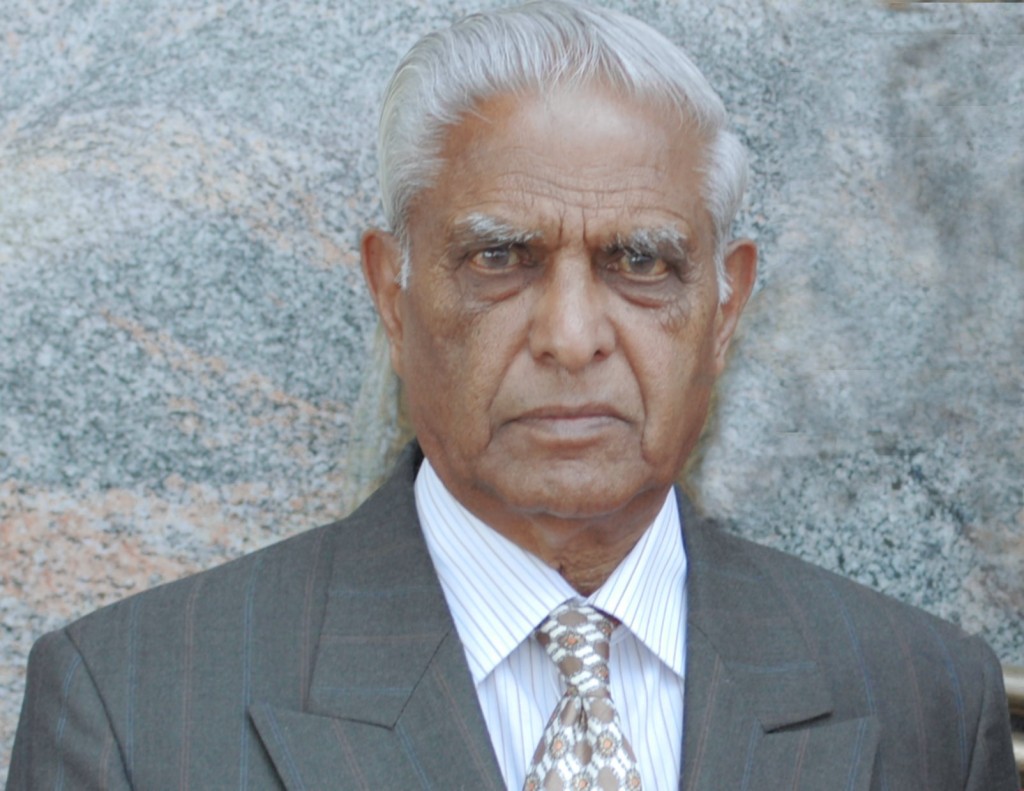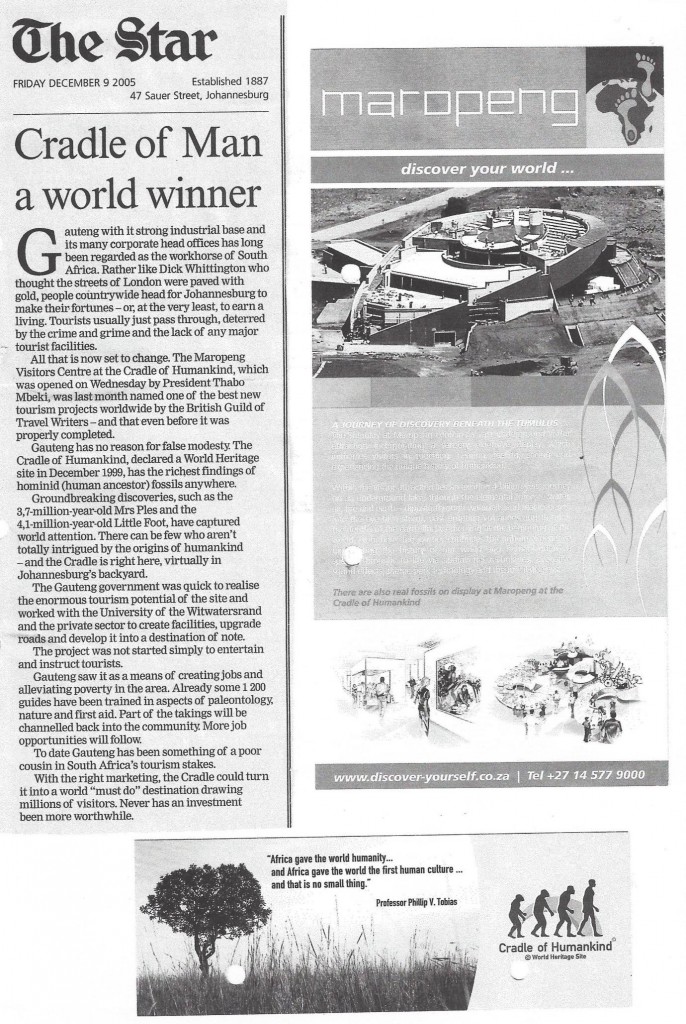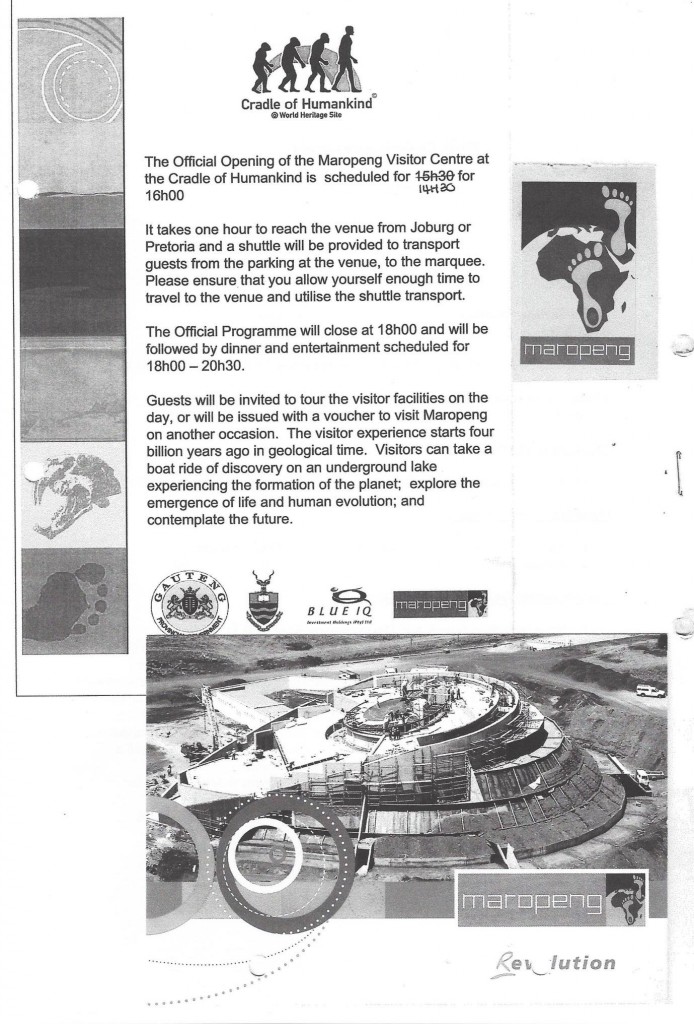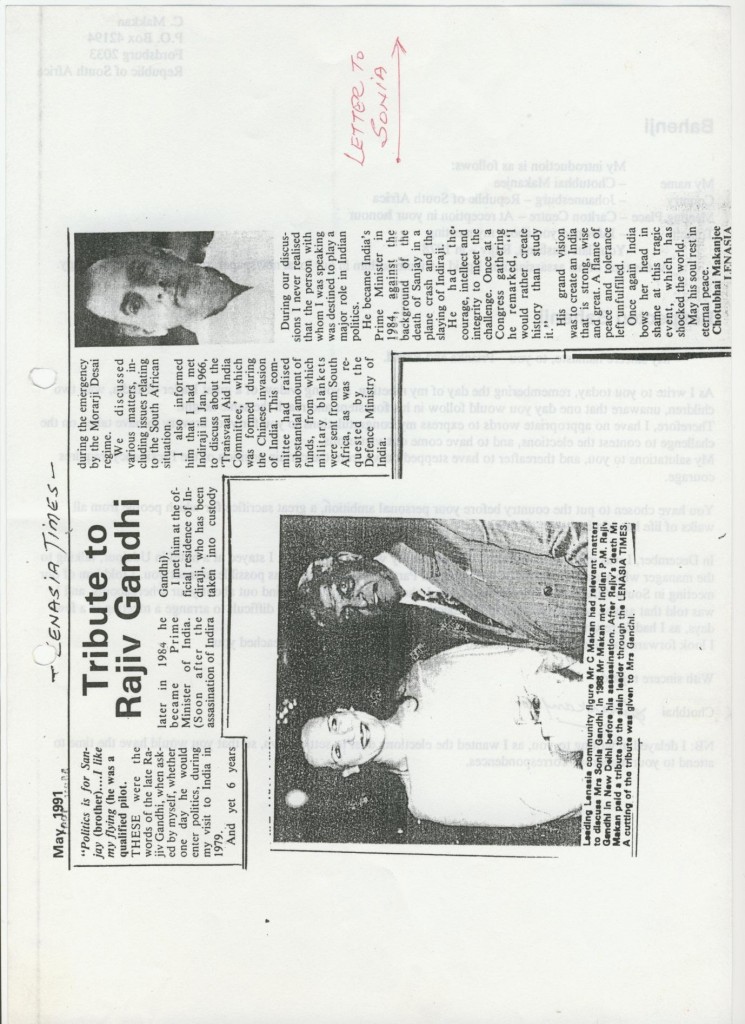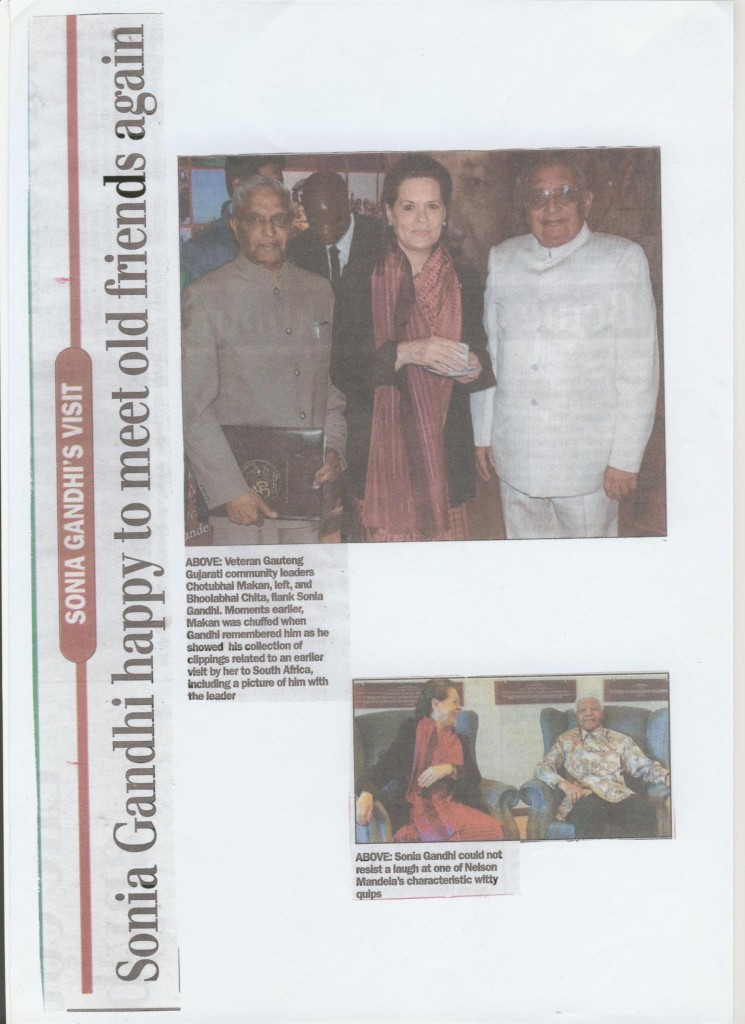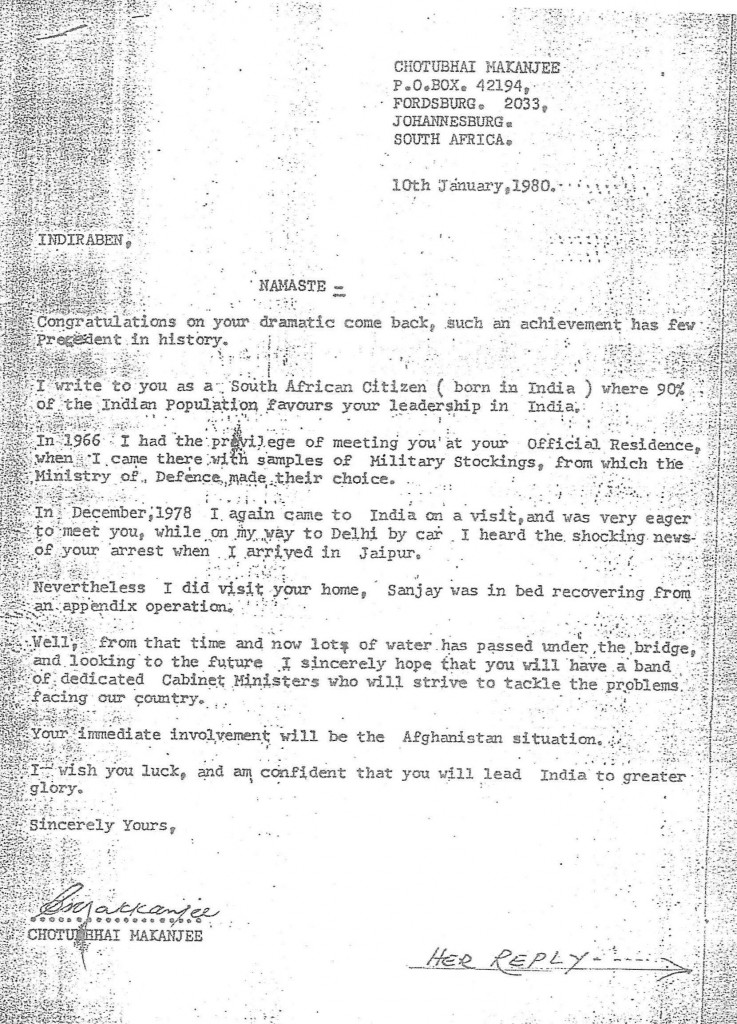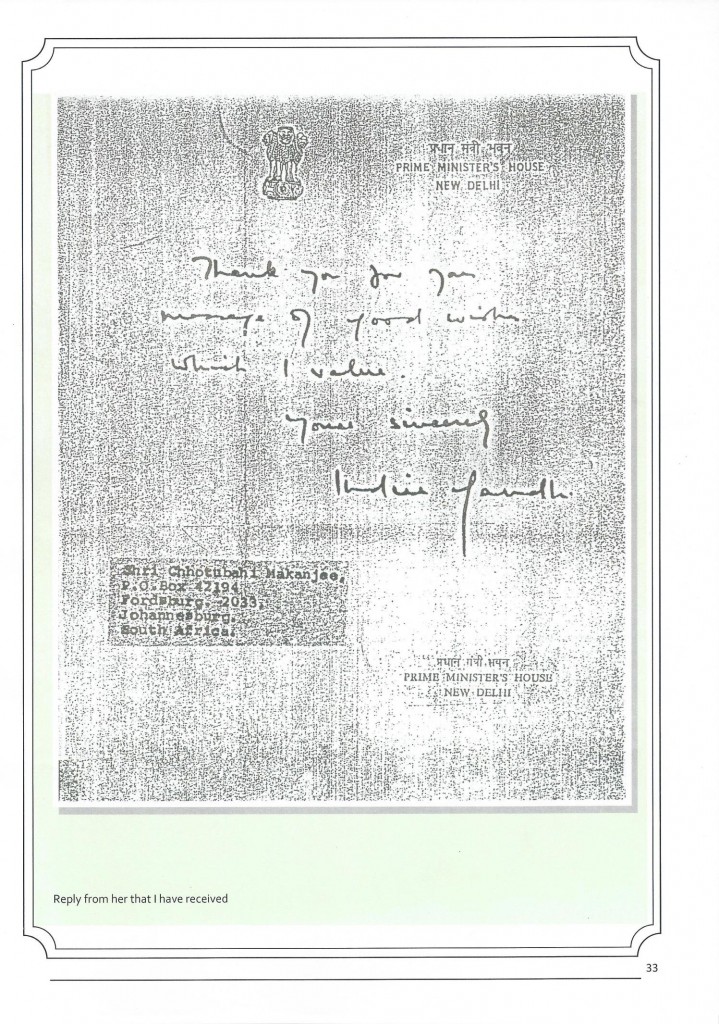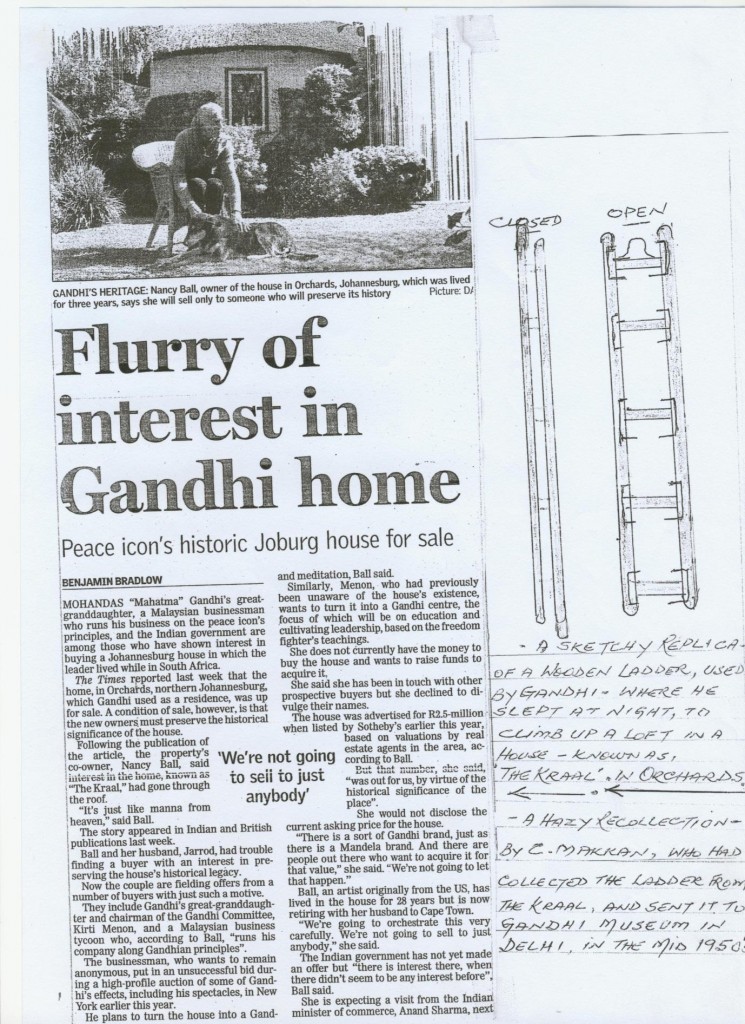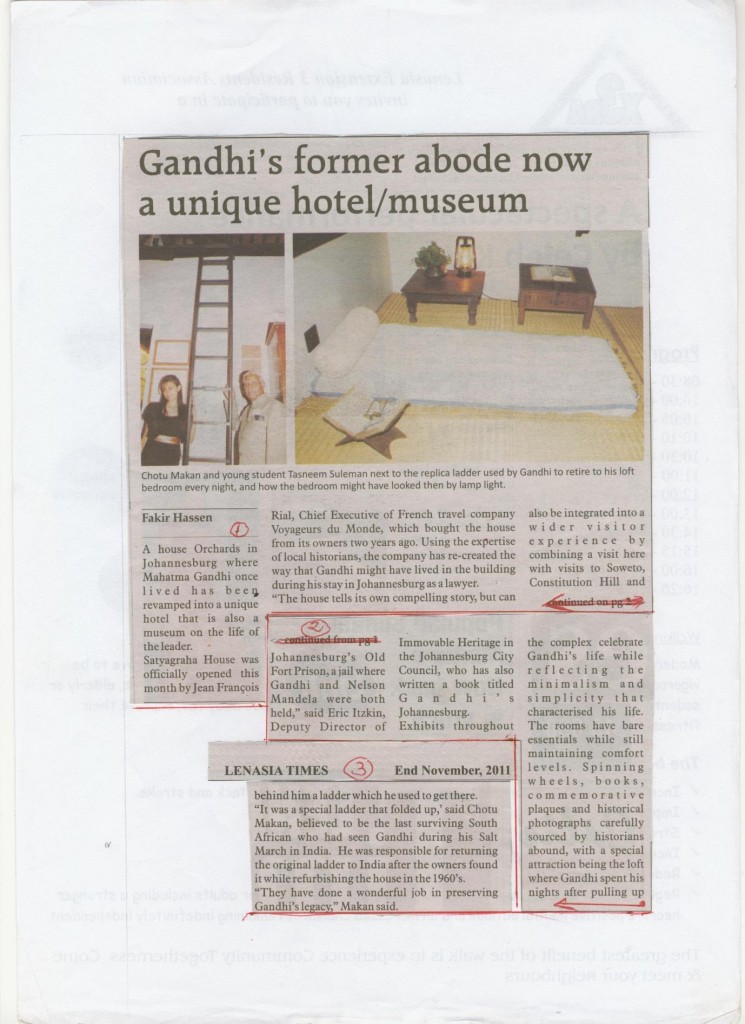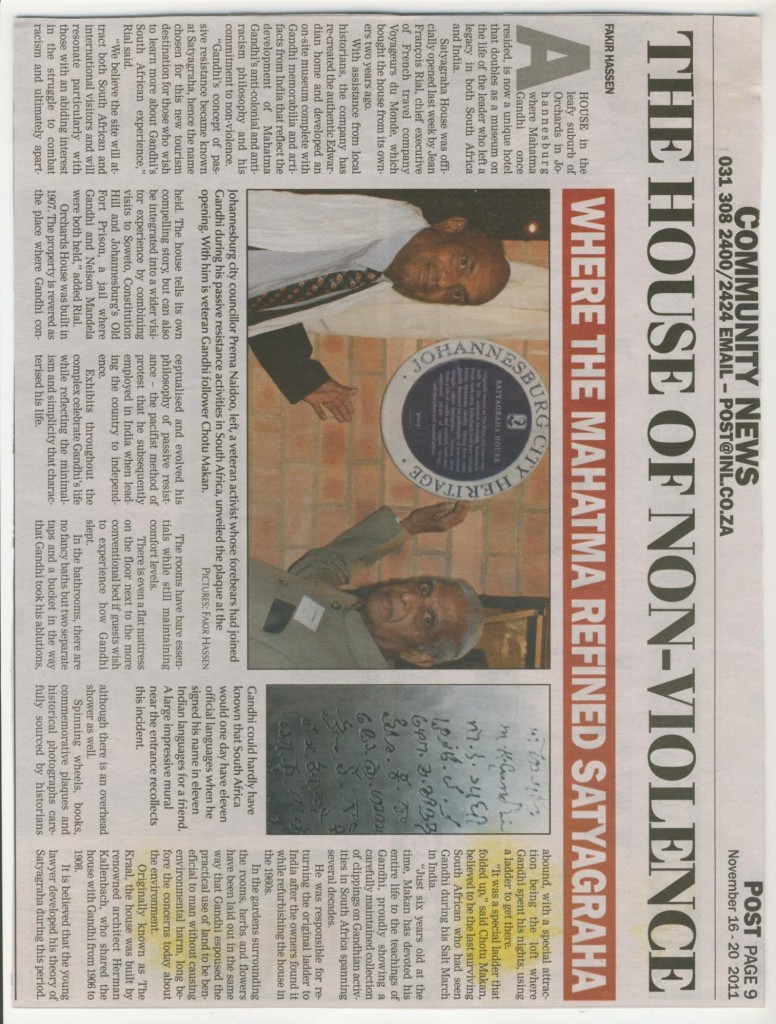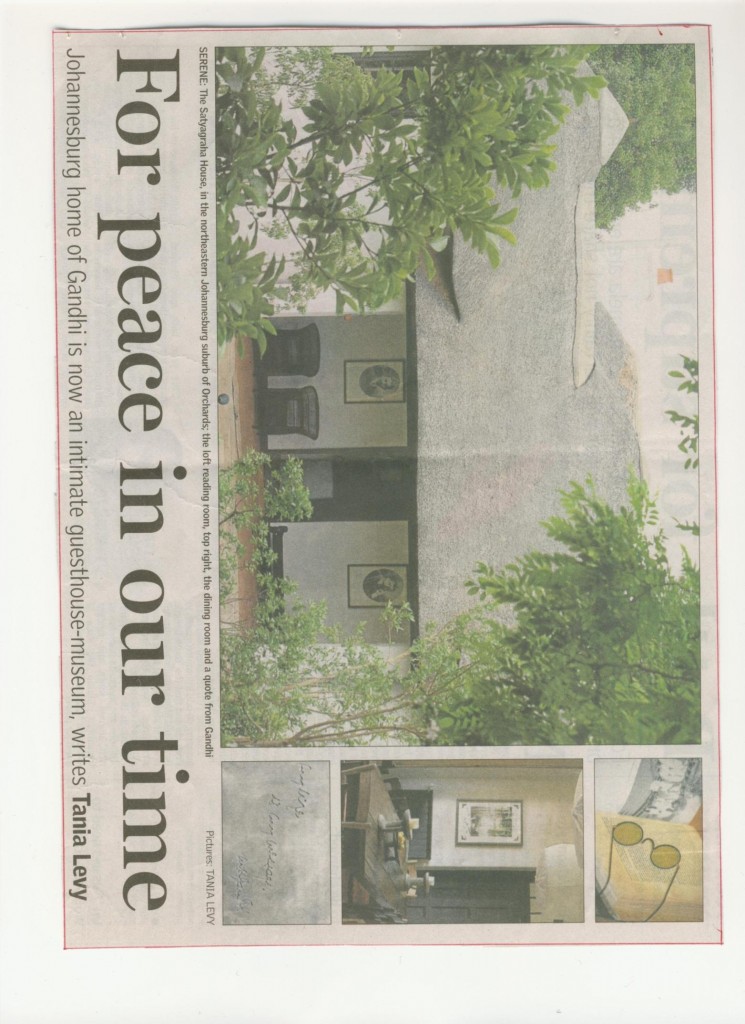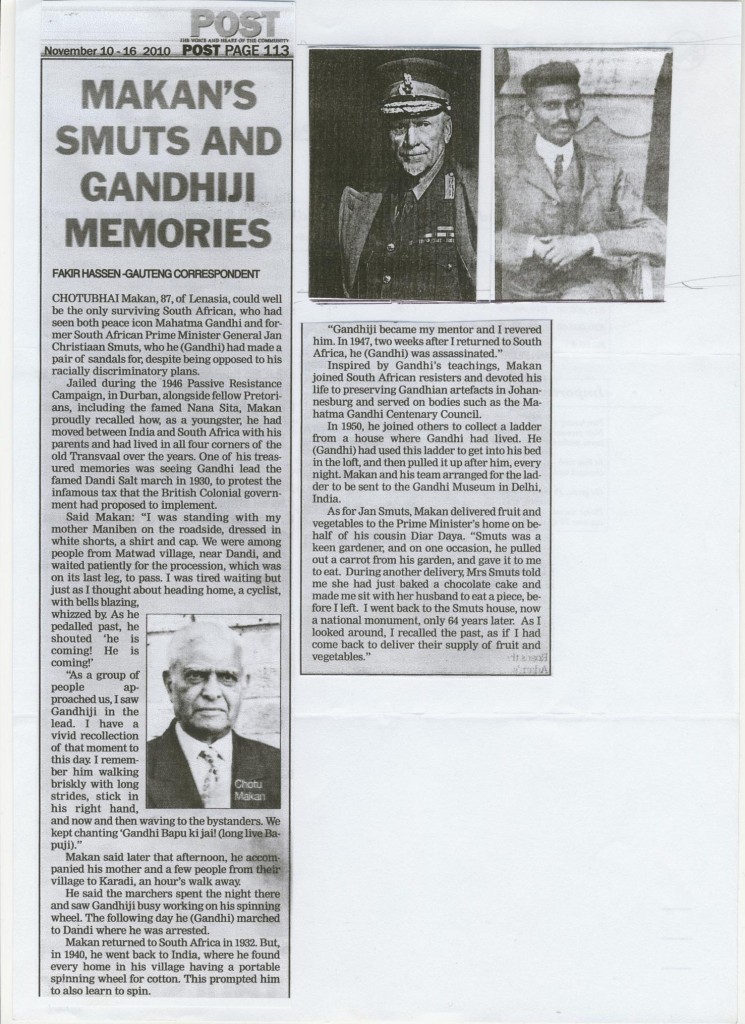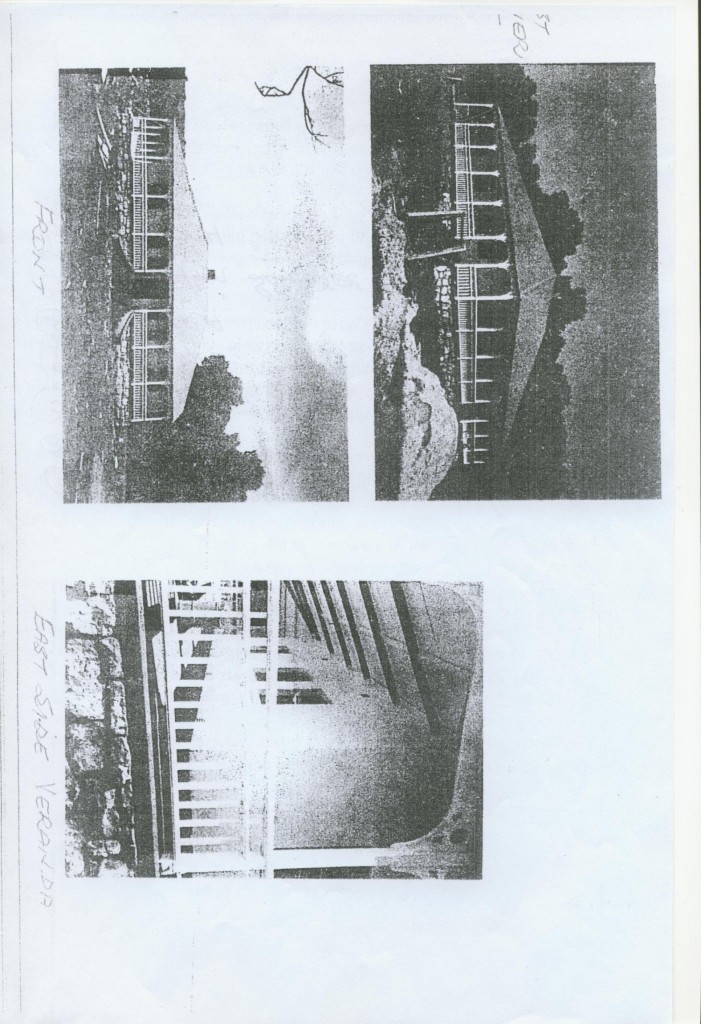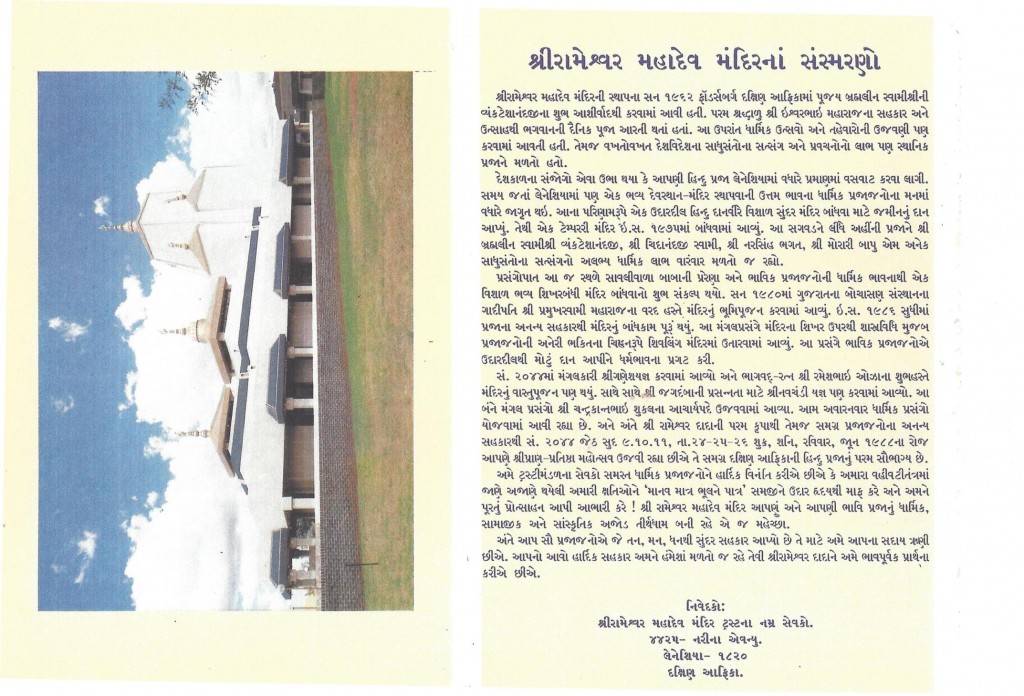New Indian Express click here to read article – Last South African survivor who witnessed Gandhi’s Salt March dies
Respected Reader,
Just over ten years ago, I had a notion that I should recollect some of my life’s experiences and put them down on paper.
And as I began, I amazed myself as thoughts and incidences came to mind.
I never realised that I had met so many eminent persons, leaders, politicians and spiritual personalities. And with most of them I was fortunate to have exchanged a few words in my modest way. Others, I could only console myself to have seen them personally, one would not have seen them, before the advent of television, let alone meeting or talking to them.
From my early years I had that urge to meet public figures, read about them, emulate and quote them. Furthermore, my eagerness to attend meetings, be it social, religious, political or any which way may be beneficial to my way of life, which over the years had broaden my vision and in view of that, this, my memoirs are its testimony.
Therefore, in all humbleness, I have endeavored to portray those events to you.
C. Makkan (Chotubhai) (2012)
******* download PDF version of this page here –>Memoirs of Chotubhai Makkan
__________________________________________________________________________________________________
Contents:
Introduction
My Personal Life
My Association with Eminent Persons
Memorable Events
Politics and Relevant Matters
Rajiv Gandhi
Sonia Gandhi
Chief Dr Albert Luthuli
Flying Pilots ‘A’ Licence
General J C Smuts
Smuts and Gandhi
Tolstoy Farm
Samaj
Swadhyaya
Rameshwar Mahadev Mandir
__________________________________________________________________________________________________
My Personal Life
(In Brief) Up Till 2010
Name: Chotu Makkan
Born: 01/06/1924
Place Of Birth: Avdafalta in Matvad Dist, Surat, Gujarat
1932 – at the age of 8 years – I came to South Africa and stayed in Pretoria.
Education: English standard 4 (Equivalent to Grade 6 today).
Activities: Early life. Daily morning exercises in an enclosed yard (under an instructor) yoga, acrobatics, boxing, wrestling sports: cricket and football.
1940 – I left school and started working
1941 – I received my motor car driving license
1946 – I attained my pilots “A” license
In the same year I took part in the passive resistance struggle.
1948 – I got married in India and thereafter we lived in Pretoria, Springs, Fordsburg and lastly Lenasia.
Leisure activities: Reading, writing, gardening, feeding birds (pigeons) every morning and my pet cats.
Religious commitments: Regularly attend the Rameshwar Temple for evening prayers. (Conduct home prayers daily – morning & evenings).
2004 – My family celebrated my 80th Birthday at the Gandhi Hall. (Grand Affair).
2008 – Our children secretly arranged to celebrate our 60th marriage anniversary at the Gayatri Pariwar Temple which was a surprise event for us. ( Admirable)
N.B. Other than the above, most of the events in my life has been covered in the various chapters of my Biography. (Written by myself.)
_________________________________________________________________________________
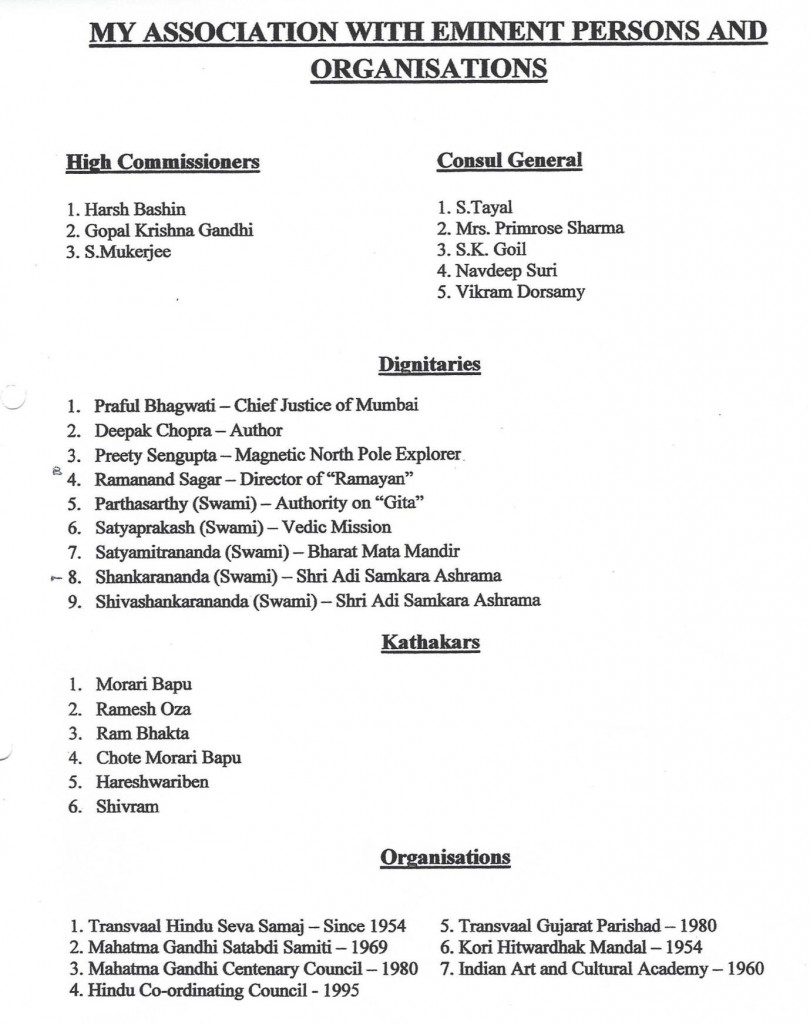
_________________________________________________________________________________
Memorable Events
1930
Gandhi: At the age of 6 years, I was standing with my mother on the roadside when I saw him walking with his Satyagrahees, on the historic Salt March in Dandi.
1942
Sea Plane: ( Looked like a huge white bird)
Which takes off and lands in water an in which I had the opportunity to fly along the Durban beach, while on holiday. This was a coincidence as just about 8 months prior, I had driven some eminent persons in a car to the Vaal Dam to welcome Pandit Kunzru (Agent General of India). He flew in a seaplane from Durban, as the normal flights were suspended because of war and disembarked at the Vaal Dam. Since then I was eager to fly in the seaplane. On my return trip from Durban, I came by plane as the service had resumed again. During the flight I had the opportunity to sit next to the pilot for a while – this was the time I decided to take up flying.
1944
General Smuts: On a few occasions I met him at his house in Irene, Pretoria, when I accompanied my cousin, who was supplying fruits and vegetables. He would be sitting, smoking his pipe on the front verandah of a wood and iron house, and would always return greetings in a very pleasant manner. On one occasion I sat on the same table with him and enjoyed a slice of chocolate cake, baked by his wife – a very pleasant lady.
1946
Pilots ‘A’ License: I became the first South African Indian to attain a pilot’s license at the Wonderboom Airfiel – Pretoria.
His Highness Aga Khan: I had the opportunity of meeting him during his visit to Pretoria and had a ten shilling note autographed by him and also decorated a chair for him with green satin material to sit on and take a photo with the Khoja family for whom I was working.
Furthermore, as a non Ismaili, I was chosen to drive him and Begum (his wife) in a new Lincon Zypher car especially acquired for him to visit all the businesses owned by the Khoja community – but unfortunately the city council provided a chauffer driven car. Thereafter, two years later his son, Prince Aly Khan, also came for a short visit. With him it was easy going and with the Khoja friend of mine we moved around. Once as I was standing near the car door in which he was sitting, a reporter of “Pretoria News” took a photo and my reflection was in the photo. Prince Aly Khan succeeded The Aga Khan as head of the Khoja community.
Passive Resistance Campaign: Four of my friends and myself made up the third batch of volunteers from Pretoria and went to Durban to defy the Group Areas Act and were sentenced to thirty days hard labour. Our Diwali was spent at a quarry in a remote area of Greytown.
1948
Jawaharlal Nehru: He was standing in a military Jeep with folded palms, greeting everyone gathered on the Bombay Docks. He had come to welcome India’s first Battleship named “Vikram”, a majestic sight, as it was making its way towards the docks – the flag of India impressively fluttering and the sounds of the guns becoming louder.
Indian Youth Congress: (Pretoria Branch): I was elected treasurer. Thereafter, was continuously harassed by the “Special Branch” detectives – was interrogated on three occasions at Merrytime House in Pretoria, and again at “Grays” Building in Johannesburg in 1966.
1959
Chief Albert Luthuli: He was invited by the youth organization of the Hindu Seva Samaj as the guest speaker on Jawaharlal Nehru’s 70th birth anniversary, at the Ghandi Hall, Fox Street, I was privileged to preside on the occasion.
1966
Indira Gandhi: Prime Minister of India – I met her at her official residence in New Delhi. I informed her about funds raised by the “Aid India Committee” Johannesburg, which was formed during the Chinese invasion of India. After consultation with the government department a large quantity of military blankets were shipped. And with the funds left over, we contacted the military headquarters, and were informed that they required military stockings. I came with few samples for them to choose from. She arranged a Jeep for me to be driven to the headquarters where I displayed the samples before the military personnel standing around a huge oval table, and made their choice.
Lar Bahadur Shastri (Mrs): Visited her home to express my sympathy on the death of her husband who died of a heart attack in Russia. I communicated through an interpreter. One can only admire their simple way of life.
1978
Rajiv Gandhi: Met him at “Teen Murti” the official residence of Nehru. Among issues discussed was the tense situation in India, because just two days prior his mother, Indira Gandhi, was jailed by the Morarji Desai’s Cabinet. We discussed various events, including flying as he was a qualified pilot. I also informed him of my audience with his mother in 1966 and the purpose of my visit at that time.
1995
Sonia Gandhi: Met her when she visited South Africa with her son Rahul and daughter Priyanka, at the Carlton Hotel reception. Discussed my meeting with Rajiv and showed my tribute I had made on his death in Lenasia Times, (S.A), and she asked to keep the cutting.
Preety Sengupta (Mrs): We met on many occasions when she visited South Africa. She is the first Indian women to have set foot on the magnetic north pole, she has also explored the dense forests of the Amazon and deserts of Africa. Calls herself “a poet by vocation and a traveler by Religion”.
1995
Transvaal Hindu Seva Samaj: Was established in 1932 of which I became its 15th president in 1995 and served in that capacity till 2001 (6 years). The Samaj is reckoned as the premier organisation of the Gujerati Community, and all activities are held in Gandhi Hall, Lenasia.
I have served the Samaj in all the sub-committees, especially the school committee, the hall planning and the building committees, the sanskar, the management etc. Most of the committees were formed for specific purposes since 1955.
1998
Attended “The All Africa Hindu Conference” in Nairobi, as a delegate of the Hindu Co-ordinating Council, which was marred by a bomb blast on the American Embassy, causing casualties and destruction resulting in the closure of the conference.
2004
Bhairon Singh Sheharwat: Honourary Vice President of India. I met him at the Indian Embassy, Pretoria where he represented the Indian Government at the 2nd term Inauguration of Thabo Mbeki. Our discussion centered around Tolstoy Farm.
2005
Jagdish Tytler: Minister of State for Overseas Indians. I met him at the residence of Shri Suresh Goel the Consul General. He was visiting overseas countries, to invite Indians abroad to attend the Bharatya Pravasi Divas, to be held in Mumbai. Our topic of discussion was my meeting with Indira, Rajiv and Sonia; of whom he mentioned in his talk and that he had high regard for them.
Nelson Mandela (Madiba): It was the 50th anniversary of the Freedom Charter celebrations in Kliptown at the Walter Sisulu Square of Dedication on the 26th June 2005.
I was requested to recite a Hindu prayer with four Priests of other denominations, where I had the opportunity of meeting him on the stage, sat next to him and had a quick introduction.
2005
The Freedom Charter: On the 26th June 2005 the 50th anniversary of the Freedom Charter was celebrated in Kliptown on the very place of its adoption, the area 50 years ago. Now named the “Walter Sisulu Square of Dedication”, which was officially opened. The entrance to the event was strictly by invitation, for security reasons, and also that the venue could accommodate a certain number only.
My invitation came from the office of the Premier of Gauteng, also requesting me to offer a Hindu prayer, which I confirmed.
As I entered the massive venue, which was almost full to capacity, I made my way to the stage, just at the time my name was called out on the sound system, informing me to come to the stage and to contact one of the volunteers. Coincidently, I met up with the person from the Premiers office with whom I was in contact. She led me to an area which was set aside for the VIP’s where I was introduced to three Priests representing other denominations.
From there we were taken to a canteen area where we had an opportunity to meet most of the cabinet Ministers and other dignitaries and partook in the refreshments provided. We introduced ourselves to each other and became friendly.
At the appointed time of the commencement of the celebrations, we were led onto the huge podium, on which Nelson Mandela, Thabo Mbeki, the Mayor and the Premier of Gauteng, Mrs Sisulu, Mrs Nokwe and the representative of India were seated.
As we were lined up, one of the Priests enquired from the programme directors, as to the order we are to follow to recite the prayers, and we were told that it was up to us to decide. My suggestion was that the Rabbi goes first. But they all felt that as an elder I should lead
.
I walked up to the microphone, aware of the vast selected gathering, and Eminent Dignitaries on the Podium. I started the prayer by chanting the Gayatri Mantra, followed with the Universal Prayer of Swami Sivananda. It went off well, and I was relieved, considering myself blessed.
Soon after the prayers, I took permission from the security to meet Madiba, sitting on the stage. I greeted him with a handshake, and we had something in common to talk about, and that was regarding the late Jasmat Nana (Jessi), as he was fondly called by those associates who were close to him during the struggle. I introduced myself as a very close companion of Jessi. Thereafter, I reminded him of our meeting at the official opening of the Gandhi Hall in Lenasia, performed by him in 1992. During our discussions, I also mentioned that I was present with Jessi on that Historic Day 50 years ago when the Freedom Charter was declared and that we also signed it. He was amazed and happy, shook my hand and congratulated me.
To me the celebration of the Freedom Charter was an emotional moment. Firstly, because I was present when this Historic Event took place 50 years ago, at this very same venue and signed the declaration. Secondly, for having had the opportunity to recite the opening prayer and thirdly, I was fortunate to meet Mr Mandela where we exchanged a few words in common.
2005
Cradle of humankind: The site where hominid fossil were discovered and later declared as the world heritage site by the United Nations in 1999, is located in the Maropeng Area.
I was invited by the Premier of Gauteng, The Honourable M.Shilowa, to the official opening of the “Visitor Interpretation Centre”, and was requested to take part in the Multi-faith ceremony, and to grace the proceeding with a Hindu Prayer.
Among the Dignitaries seated on the stage was the Premier, the President, and Palo Jordaan, Minister of Arts and Crafts
After reciting the prayer, I came over to my seat, just behind Thabo Mbeki. He turned around and shook my hand, and thanked me. In reply I said: “I am honoured, Mr. President,” and thanked him.
In my closing remarks of the prayer I mentioned:
“O Lord, may thy grace be upon our President, our Premier and our Leaders gathered here at this Historic Heritage Site, being One of Thy Divine Glories.”
2007
Ambika Soni: India’s Minister of Tourism, who represented India on the occasion of the 100th year celebrations of the burning of permits which was compulsory for Indians to carry, under the Asiatic Act. Besides giving her overviews of the Tolstoy Farm, I expressed my disappointment at the condition of the historic site, set aside for the development in the memory of the famous Dandri Marrah by Gandhi in 1930, which was the starting event of India’s struggle towards freedom.
She informed me that the planning is in its final stage, and the project was to start soon, with a new service road to be built to link the area.
_____________________________________________________________________________________
POLITICS and RELEVENT MATTERS
I was associated with persons who were actively involved in Politics from my early age, living in Asiatic Bazaar Pretoria. I used to attend meetings, helping them in distributing Handbills, etc.
In 1946, during the Passive Resistance Campaign against the “Group Areas Act”, I became active, enrolling the would be passive resisters, arranging transport with other members to ferry them to Pretoria Railway Station, or at times to Johannesburg, so they could be included in batches leaving for Durban, to defy the Act, and court imprisonment.
After sending off the 2nd second batch from Pretoria, I realised that mostly the Tamil speaking men and women were volunteering. So I decided to speak to an elder person, who had shown his willingness to participate in the movement. He showed his eagerness and took the initiative to approach a few of our close associates and we made a batch of five, (all Gujaratis).
The campaign was launched in defiance of the obnoxious Act, by the Natal and Transvaal Indian Congress (Dr. G. Naiker & Dr. Y. M. Dadoo as the Leaders). We Informed the Transvaal Committee who was in charge of registering the Transvaal Resisters, and sending them to Durban. On reaching Durban, we reported to the Committee there. After taking down our details, we were given a few hints by way of a pep talk as what to expect in Prison, such as bad working conditions, unhygienic food, water, dirty clothes, lice filled blankets, etc. . .
Thereafter, we were given the option if we wanted to go ahead, or wished to back out.
Having finalised all the aspects, we were given supper at a Private Home as we were all vegetarians. Thereafter, at about 7 pm, we were driven to the spot and were told where to stand.
While standing we started shouting slogans: “We shall resist, “Inkalab Zindabad” down with the Group Areas Act,” etc. There were many other Indians standing further away from us and they all joined in the slogans.
A Police van pulled up with three Policemen near the spot where we were standing just before this batch of seven resisters from Durban also joined us. One of the policemen read out an ordinance and told us to move or we will be arrested for trespassing.
Our batch leader, who was well versed in Afrikaans, gave our reason for being there. For a moment it was all quite, than their Superior came forward, he too spoke in Afrikaans, telling us that he could see that we were from the Transvaal and are decent people and why do you want to go to jail with such (bad language) referring to the Durban Resisters, and moved away from the van, instructing his colleagues to arrest us.
We were locked up at the back of the Police van and taken to the Charge Office. After the normal procedure, we were taken to the cell at the Police Station.
The cell had a foul smell, it had cement floor and a toilet bucket in one corner. There were few blankets, which we folded to sit on it, next to the wall, so that we could rest our backs against the wall and stretch our legs. That is how we spent the first night in a police cell.
The next morning we were taken to Greytown in a truck, in a squatting position and crammed up. It was a clean, small jail. The enclosure was presentable. The cell was large, clean, and had wooden floors. We were given jail clothes – our clothes were taken away in packets – and the changeover was in the open, standing nude until the clothes were thrown to us. Size did not matter and they were filthy, with white lice in every fold. The same was with the blankets, 2 to each person. Food was thrown in our aluminum plates with two pieces of bread. (You have to eat fast, stand up and go to your cell, when the Induna commands:. I used to eat the soft parts of the bread, the outer crust I used to put in my filthy trouser pocket, and ate it slowly in the cell, as soon as we were locked up).
The first day was spent in the courtyard cleaning doors, windows, and gardening.
The following day and everyday thereafter, we were taken to a quarry, where we were given hammer-like tools to break rocks. The warders, who were looking after us, were sympathetic and never bothered us. They used to move around in a nearby filed looking for medicinal plants.
A noteworthy unforgetful event just a few days before our release, we noticed an Indian woman standing with a basket near one of the warders for some time as if pleading. She then walked to the nearby tree and put her basket down and sat under the shade. The warder came to our leader and asked him if it was our Christmas (than only did we realize it was Diwali). The warder told our Leader that the woman had brought us tea and biscuits, but he can’t allow it, as it was against the rules. We all pleaded with the warder to let us enjoy her tea, so that she would not be disappointed. From her dressing one could see that she was from a poor family.
At lunchtime the basket was brought to us with a few cups, 2 flasks and 2 packets of Marie biscuits which we shared equally with the warder. (That was an unforgettable Diwali for us.) After we finished, our leader asked the warder if he could go up to the woman just to thank her but it was not allowed and the warder took the basket to her. We all stood up and started waving to her and she waved back. (That we felt was a mutual inner satisfaction).
In our cell that night we spoke of the thought behind her good Samaritan, the efforts she made so that we could enjoy a little extra on our Diwali Day. We also discussed if there was any possibility of meeting her, but that was futile as it was a very remote place, where we were taken to work.
When our term expired with the normal remission. We had served 21 days. As we walked out from the jail gates, there were some people waiting outside to take us to their homes, where we all had a bath, and thereafter had lunch. We were than driven to Durban, where we were met by people who were involved in organising the campaign.
There we were served refreshments, and later took us to the railway station for our journey back home.
The next day being Sunday, there were about 25 people including our family members, who had come to meet us at the Pretoria Railway Station.
After a few weeks some sort of agreement was reached with the Government and the Campaign was called off.
Personally, I experienced inner happiness that I was fortunate to have played a minor roll in defying the obnoxious Legislation.
1951
The Transvaal Indian Congress Youth League (Johannesburg) had arranged a get-together in Asiatic Bazaar Pretoria, with the intention of forming a Youth League Branch.
Youth from Johannesburg had arrived in two cars, and the local youths were invited. I was also present.
During the formation of the Youth League Branch in Pretoria, I was approached by the brother of Nana Sita, to accept the nomination as a treasurer, which I agreed. Unaware that the person sitting next to me was an informer, who was on a pay roll of the special branch.
The next morning at about 10am I was picked up at my place of work and taken to the Special Branch headquarters in Merritime house, near Church Square, which was the Central Area.
There I was interrogated by the head of the Special Branch, (Sgt.) Van Der Berg. After about 15 minutes of grilling, it was agreed that I should resign and a copy of the resignation must be handed to his office in the same building.
Although I carried out the instructions, the committee never functioned as members came to know who the culprit was who had given the information. Yet, whenever any political meeting were held, I was picked up at my work place, taken to a lonely spot by the Special Branch as they wanted to know from me who organised the meeting and who were present. Even if I had not attended the meeting, I gave them all the information I knew, knowing well that they are already aware of all the happenings.
On the other hand, because the visits of the Special Branch were frequent, the owner of the wholesale grocer was not happy, and hinted that I should look out for another place to work.
Just at that time I was approached by Mr. Jasmat Nanabhai, who was very active in politics. He was the Treasurer of the Transvaal Indian Congress. He came to Pretoria one day with a proposition that I should go to Springs to manage a grocery store owned by Mr. N. Parbhoo, a staunch congress supporter, whom I knew well.
I discussed the situation with my wife, and it was a mutual agreement, that we move to Springs, to avoid the harassment by the Special Branch. The setup there was very favorable, as our living quarters was behind the shop building – 2 large rooms, and a kitchen – much more convenient than the Pretoria one which was a make shift room and kitchen in a garage.
I felt secure thinking that it was a good move to have left Pretoria. But about 3 months later, as I was serving a customer taking down his grocery order, I was disturbed by a Voice, “Excuse me”. As I looked up, there were three detectives standing. (You can recognize them by the type of hats they wear.) One of them produced his pocket diary, with a card and his photo on it. At once I sensed the situation, but before I could speak he told me politely to carry on, and they would wait. My customer also realised that I was uneasy, told me to attend to them, and that he would see me later.
Thereafter, one of them asked me if we can talk in private and I took them in our storeroom linked to the shop. Out of the three, one was from Springs. After many questions, answers and discussions, the one from Pretoria asked the one from Springs if they had any problems with me, and he said nothing so far, but he was told in Afrikaans to monitor my movements, and report to them if I become involved in any activities.
Thereafter, we walked back to the shop, and I offered them cold drinks. They became very friendly and also polite and parted with a handshake. And that I took to be my last confrontation with the Special Branch. So I thought! Little did I realise that I was constantly monitored?
In 1954 I left Springs and settled in Fordsburg Johannesburg.
In 1966 I had the opportunity to visit India. The visit was for a specific purpose, as I was asked by the treasurer of the “Aid India Committee”, which was formed during the Chinese Invasion on India in 1962. I took with me five samples of Military stockings from which they in the Military Dept to choose.
After six weeks in India I returned. I was staying in a penthouse above a Three Storey Building, with my family. A few days after my arrival when I came home from my place of work in the evening, my wife gave me a slip of paper which, she said, was left by a white man who only spoke Afrikaans, which she did not understand. The message on the slip stated that I was to report at the Grays Building, a room on 5th floor at ten o’ clock the next day. (When one hears about Grays Building, one is scared, because it is the Headquarters of the Special Branch.)
I was taken aback, with a deep concern and fear, trying to figure out how could they have found out my whereabouts, after twelve years, which was the last time when I was interrogated in Springs.
After supper myself and a friend, staying in the same flat went over to Jasmat Nana who was involved in politics all along and had a fair insight of the Special Branch methods of workings. We discussed many possibilities of what could happen and that the Special Branch was above the law. Therefore, there is nothing one can do legally, until if it comes to court.
It was decided by us that my friend drive me to the place and that he wait in the car until I return. That night I could not sleep, nor did I discuss the gravity of the situation with my wife.
In the morning we drove to the Grays and stopped just opposite the entrance. As I entered, the security guard came to me, and I showed him the slip of paper left with my wife. He took me in the lift to the 5th floor and showed me the room where I had to go. The door was open and I entered a empty room, with only a small wooden table and two chairs, on the opposite sides of the table. Just than the door of the room opened, a person dressed in a suit walked in and closed the door. As he was about to sit, he gestured with his hand and asked me sit. As I sat he took out a pocket diary from his jacket. He enquired if I was Chotu Makan, staying in the flat at the corner of Park and Lilian Road, I said “y”es. He further wanted to know the reason for my visit to India, and who I met there. I told him that I went to visit my mother after 18 years, and during that period my father had died, and that she was not well.
He was looking at his diary held in his left hand, turning its pages with his right hand, in a way that I could not see what was written in it. He than asked me if I had visited any places there, I told him that after a week with my mother, I took a tour accompanied by two friends, visited Jaipur, Agra, Delhi and places of worship.
He started relating my past activities and I gave him a detailed run down as to how I innocently got involved. Then came the bombshell. He told me that I also attended the Freedom Charter meeting in Kliptown (which I did), but I denied being at the meeting. To which he said I will show you a photo in which you are standing with the crowd. I asked him to show me the photo, acting innocent and composed.
I looked at my watch, it was 10:30am and I was getting worried thinking to myself that he is slowly getting me into a corner. But to my surprise he closed his diary, put it in his pocket, and told me that I could go. I got up, thanked him, made for the lift, and to the car where my friend was waiting anxiously and we drove back home, with a sigh of relief.
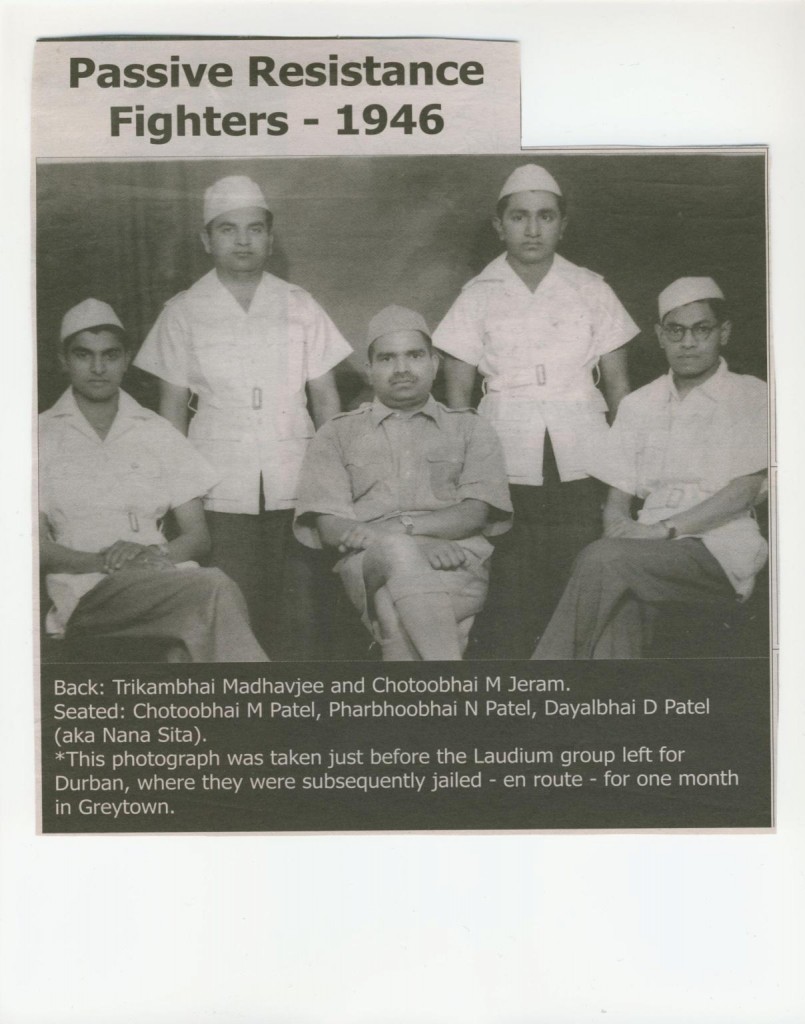
________________________________________________________________________________________________
Rajiv Gandhi
In 1978, my wife, our daughter aged 7 and our son aged 5, accompanied me to India. After spending a few days at our home in a village, we took a tour by car, visiting places of interest. Our itenary was to go as far as Delhi and thereafter return home via a different route.
After traveling for a few days, we reached Jaipur, and stopped at a filling station. We were informed that the Morarji Desai Government had imprisoned Indira Gandhi and it was therefore risky to drive to Delhi because there was a possibility of trouble.
Our driver was well versed with those areas, and suggested that we change the route and instead drove to Agra.
We went sight-seeing in Agra of various places, especially the unforgettable splendor of the majestic Taj Mahal. Through the daily news we came to know that Delhi was quite. So, we went to New Delhi, and visited ‘Teen Murti’, the official residence of Jawaharlal Nehru. I walked through the gate and saw Rajiv Gandhi standing on the lawn near the entrance.
I introduced myself and we discussed the imprisonment of his mother. He was not very concerned as he mentioned that she should be released in a few days. I then gave him an overview of my meeting with her in 1966 and the purpose of my visit at that time.
Also during our general discussion, I questioned him as to when he would be entering politics. He replied, ‘Politics is for Sanjay (his elder brother), I love my flying (he was a qualified pilot).” This gave me opportunity to inform him that I, too, had taken to flying in South Africa and that I attained my ‘Pilots A’ license in 1946, and in 1947. I had come to India to further my piloting career but, I was informed by Field Marshall Burbury (whom he was aware of) that they did not have any flying schools at that time and suggested that I should join the Royal Indian Air Force where I would receive all the training. Unfortunately, I had to sign a three-year contract, which I could not do because of my business commitments. However, Rajiv Gandhi felt that I should have taken the offer.
Summary of events:
1.Circumstances compelled him to enter politics, as Sanjay had died in a plane crash.
2.And later he became president of the Indian Congress
3.Assassination of Indira Gandhi
4.Became Prime Minister of India, until he, too, was assassinated
5.About 10 years later, Sonia Gandhi (his wife) came to South Africa. Accompanied by her son Rahul and daughter Priyanka, she attended a function that was held in her Honour at the Carlton Hotel in Johannesburg. I too was invited where I managed to get near her. We exchanged greetings and began to discuss my visit to India and my meeting with Rajiv Gandhi
6.At the time of Rajiv Gandhi’s assassination, I paid a tribute to him through a local newspaper. I showed Sonia Gandhi the press cutting which she read and asked if she could keep it. I nodded in approval and she put the cutting in her handbag. She thanked me and at the same time requested that whenever I visit India, I should try to contact her.
In December 2003, that situation arose when I went with my wife for a short visit to India. There we arranged a quick trip to Haridwar, which is a spiritual place of pilgrimage.
At a hotel in Udaipur, I enquired from the manager if there was a congress office near the hotel and gave reasons of my eagerness to meet Sonia Gandhi. He became very helpful after I related my meeting with her in South Africa, and also my meeting with Rajiv Gandhi in 1978. He phoned someone who gave him a contact number. After dialing the number a few times, he managed to contact that person. He spoke in Hindi and gave some details about me but he was told that Sonia Gandhi was away on an election campaign and that it would be difficult to arrange a meeting with her.
Sonia Gandhi was elected as the president of the Indian Congress and the Congress party was contesting the upcoming elections in 2004. If successful, she could become the second women Prime Minister of India, after Indira Gandhi (Her late mother-in-law).
________________________________________________________________________________________________
Sonia Gandhi
On the 22nd August 2007, an opportunity once again came my way by meeting the President of the Indian Congress, Sonia Gandhi, this time at the Nelson Mandela Foundation.
She had been invited by the Deputy President of the Republic of South Africa during her visit to India. The itenery for her short visit was as follows:
In Johannesburg a courtesy call on Madiba, and present a book on Gandhi to him. In Cape Town address a joint sitting of the Parliament, and in Durban she had an official engagement.
My invite to the Mandela Foundation came from the Consul General of India, Shri Navdeep Suri. The seating capacity of the auditorium is about 100 people; therefore invites were limited, to accommodate a large contingent of the Press.
She entered the hall with Mr. Mandela and was introduced to the gathering by Shri Sharma, who had accompanied her from India. The programme Director on the occasion was Mr. Ahmed Kathrada, a veteran freedom fighter, who had also served 20 years jail term with Nelson Mandela on Robin Island. After a formal welcome he requested Sonia Gandhi to address the gathering. She walked up to Mr. Mandela and made the presentation, before taking to the podium.
Soon after the completion of formalities Mr. Mandela was led out from the hall, and she followed. After that the door of the entrance was closed, so that no one could follow them. But I hurriedly walked to the entrance, and the door attendant opened the door for me, thinking that I was a V.I.P from India, as I had worn a Nehru Suit.
In the foyer outside I managed to catch up with her, and introduced myself and quickly showed her a photo of us together taken by a photographer at the Carlton Hotel, which was about 12 years ago, when she was on a private visit with her son Rahul and daughter Priyanka.
Seeing the photo she was delighted and asked if she could keep it. I told her that I had specially brought it for her and we exchanged few moments. I also mentioned about my visit to India in 2003 in December and had enquired in Udhaipur about her with the Hotel manager, who was very co- operative, but was told that she was away on an election campaign.
After some discussion, she again reiterated that I should make another trip to make efforts to meet her. But I told her that this will be our final meeting, and wished her well in her political endeavours. And with a typical greeting pose, we said Namaste. Holding the large envelope I had given her, she mentioned that a situation may arise for her to visit again and we parted, after posing for a few photos.
In India the India National Congress won that election, but she preferred to remain as the Congress President.
Shri Manmohan Singh was elected as the Prime Minister, she chose to be a constant companion, and move together with the Premier on his official duties.
One can only admire her grace and simplicity in the Indian tradition. My experience of her: “A very pleasant person to converse with”.
___________________________________________________________________________________________
my meeting with . . .
CHIEF (DR.) ALBERT LUTHULI
A youth organisation under the auspices of the Transvaal Hindu Seva Samaj, invited Dr. Luthuli as a guest speaker on the occasion of Jawaharlal Nehru’s 70th Birth Anniversary at the Gandhi Hall (Fox Street). I was asked by the organization to accompany them to the airport to welcome Dr. Luthuli.
He was dressed casually and was carrying a suitcase. We exchanged greetings and was then garlanded in the Indian tradition. We took him to Fordsburg where arrangements were being made at one of the organisers homes. It was near evening, and after some discussions regarding the meeting agenda, we had supper. After this, he got ready for the meeting, changing into a navy blue suit, white shirt and tie, and black shoes, which he carried in his suitcase.
We arrived at the Gandhi Hall at 19:45 pm as the meeting was scheduled for 20:00 pm. As we entered the Hall, a trustee of the Samaj with other elder members, welcomed the Dr. at the entrance and guided him towards the main table on the stage where he was fitted with a Gandhi cap.
I was accorded the privilege to preside on the occasion. After my opening remarks, the chairperson of the organisation welcomed the gathering and introduced Dr. Luthuli, after which he was garlanded. This was followed by applause from an appreciative audience, who had filled the hall to its full capacity.
Thereafter, an entertaining dance item was performed by a group of Indian schoolgirls. Soon after the dance item, I requested our guest of honour, Dr. Luthuli, to address the gathering. With the Gandhi cap on, he stood up and walked towards the podium to a thunderous applause.
He spoke for 45 minutes on Nehru’s life and his contribution to mankind. As he walked back to the main table, he was overwhelmed by a standing ovation.
A QUOTE FROM HIS ADDRESS FROM THE 45TH NATIONAL CONFERENCE
IN 1975:
“The length of the term of slavery –
depends largely on the oppressed
themselves and not on the oppressor”.
____________________________________________________________________________________________________
Pilots ‘A’ Licence
How it came about?
There were two reasons which prompted me to taking flying lessons: –
1.A flip in a sea plane, over the Durban coastline.
2.Sitting with a Pilot in cock-pit, on a maiden flight from Durban to Rand Airport, Johannesburg.
I attained my licence in 1946, which was supposed to be the first Indian in South Africa, at the time. An article appeared in the “Indian Opinion” to the effect with my photograph.
Before I was tested, for my flying skills, I had to undergo medical tests. The doctor who examined me jovially remarked, I quote “that only birds and fools like to fly” (His reasons will be known as you read on).
All this started, during the official visit of Pundit Kunzru as Agent General of India, who flew from Durban in a sea plane, which landed on the Vaal Dam. I was among a group of people who had travelled from Pretoria, to join others who had gathered to welcome him.
Watching from an area near the dam, i watched in amazement the landing of the sea plane which appeared like a big white bird on the water. This fascinated me, hoping that one day i would try for a flip in it. Fortunately, it so happened that not so long after the episode at the Vaal Dam I accompanied a friend to Durban for a holiday and while enjoying the vacation, I was walking near the docks one day and there I saw sea planes taking off and circling the area and landing which, i was told, was part of their routine morning exercise.
I did not hesitate to enquire if it was possible to book a seat to fly to the Vaal Dam, but was told that they had discontinued the flights, as the regular service by normal planes are to re-start, between Durban and Rand Airport. Nevertheless I approached a person sitting in the office, to allow me the opportunity to experience a short flip in these planes even if I have to pay for it. Reluctantly, he agreed and we flew above the coastline, and then landing in the sea at no charge. It was exciting experience.
Although I had come from Pretoria by train with a return ticket, I decided to go by plane. I made enquiries and booked on a maiden flight to Rand Airport. These services were discontinued because of the wartime risks. And on the day this service was resumed, we were about fifteen passengers and three crew members.
Soon after takeoff, as the plane was cruising high in the sky, I thought to myself that one day I must also learn to pilot a plane. After about half-an-hour of flying, I undid my seat belt and walked to the cock-pit. The door was wide open and i stood there curiously looking at the various instruments the pilot was friendly and gestured for me to sit, we could not converse freely because of the engine noise.
After landing I thanked him for having allowed me in the cock-pit. And he, in turn, wished me luck as I had mentioned to him my intention was to take up flying.
A few months later i came to know that a friend of mine was taking lessons in flying at the Wonderboom Airfield, which was about a half an hour drive from Pretoria Central. I met him and after discussing my intention to join, he encouraged me and was very helpful. I went with him a few times to see the place, how he was being instructed and other formalities.
Thereafter, i enrolled as a member and started taking lessons. A fee of five pounds had to be paid for one hour, a lesson takes about 15-20 minutes. The most crucial aspect in flying is the take-off and especially the landing, which is difficult, (even if I have to say it). You have to have good judgement of the height and the run-way, or you may damage, or even crash the plane in the fence at the end of the runway.
And because of that many learners had to give up, or the company would stop giving lessons, because of the risk involved.
Somehow, I had the judgement, and therefore after eight hours of solo flying (which normally takes twelve hours), I was tested to qualify for a pilots “A” licence, and i was successful at my first attempt. (Flying, medical and written exams will follow at the end).
It so happen that in 1947, i had to go to India for personal family matters, and while I was there i decided to further my flying career. After making some enquiries in Bombay, I was granted an interview by the field Marshall Burbury in his spacious office in Ballard Pier.
He informed me after a lengthy discussion that they are no such schools, but suggested that if possible that i join the Royal Indian Air Force on condition that i sign a three year contract. This was not possible as i was not able to stay for that length of time in India.
And while I was there, the political situation in South Africa had changed. The National Party had won the 1948 elections. And when i returned to South Africa, I was told that we cannot use the main entrance of the station building. We had to go out by the side gates, because this was how separate amenities were enforced.
These realities I later experienced, when I went to enrol at the Wonderboom Air Field, so that I could keep up with my flying skills, and I noticed that things had changed. The company which managed the air field was taken over by the Nationalist Government.
They made things very difficult for me, in that even after making appointments by phone, when i got there, they would often say that the ground engineers were not available to certify if the plane is in good condition or, at times, would say that all the planes are booked, etc. and because of that my flying career ended.
The planes I was flying were the “Piper Cubs” and sometimes for stunt flying the “Tiger Moths”, that was with the Instructor.
Requirements, before testing for licence:
Endurance, medical, physical and written examinations.
The first time I was taken up by an instructor he performed some stunts just to see if I felt giddy, or if I’m afraid of heights, etc. Being an acrobat in my early years, it did not affect me and he was happy. After landing he signed a log book and gave it to me.
Thereafter, I was medically examined by an army doctor, by the name of Dr Prag (not Indian) who certified me fit.
He related that during the Second War, he was appointed by the Defence Department. His office and consulting rooms were in a building overlooking the airfield run-ways. “From there I watched damaged planes landing, soldiers coming out bandaged some limping, other on stretches and some of the planes crash land. Seeing these I thought to myself that only “birds and fools like to fly”. We both had a good laugh, and although i was two pounds (2 lbs) under weight, he over looked it and gave me clean medical certificate.
Having completed eight hours of solo flying without any mishap, I was ready for the practical tests. I was required to perform the following:
1.Take-off and land normal.
2.Landing without engine power.
3.Dive from 2000 feet, until you came half-way and then recover.
The most difficult thing in flying, is the landing and somehow I managed that well.
Having attained my Pilots “A” License and a short write up with my photo appeared in the Indian Opinion, which was sent by Shri Narsai Manga.
The Kori Hitvardhak Mandal in Pretoria called a meeting to honor me. Shri Nana Sita was its chairman and Narsaibhai as the secretary.
The chairperson congratulated me, with few word of praise and said that the Community is proud of your achievement, wishing me success in future enterprises, and presented a bunch of flowers.
Thereafter, Narsaibhai in his speech spoke of the risk involved in attaining such license and complimented me.
The chairman than requested me to say a few words. I related my experience in flying, and made those present aware that it was because of physical exercises and acrobatics I had training in a gymnasium during my early years in Pretoria, that I could endure the initial tests by the instructor pilot.
In conclusion, I also mentioned that what I achieved will be insignificant in time to come, as there would be many in my category. Lastly I thanked the Mandal for having honored me.
_____________________________________________________________________________________________
General J.C. Smuts
It was on the 26th January 2008 and we had gathered at the Indian Consulate to participate in the 59th anniversary on the Republic of India.
Soon after the celebration, a friend Mr. Mohan Hira, drove me to visit Smuts House in Irene which had been turned into a Museum, after the death the General and his lifelong wife.
The reason for us going there was because, one day in our general discussion, he mentioned to me that he had taken some visitors from India to see the place, and while we were moving around in the house, he noticed that in one of the rooms in a corner there is a basket placed on the stand with plastic fruits in it. Above that is a framed writing, informing the visitors that an Indian used to supply fruit and vegetables to the Smuts.
On hearing that I told him that it was my cousin,a hawker from Asiatic Bazaar, Pretoria. And I also told him that I would like to visit the house, because I used to accompany my cousin on certain days on his rounds so that I could drive his van to get more practice in driving. And after receiving my driver’s license, he would send me alone at times with his African worker, specially on Wednesday.
During that period I had the opportunity on three occasions to see the (Prime Minister of the Union of South Africa. The Honorable Field Marshall Smuts) As he was known at that time. But for us he was (ou baas) “Elder master”. I was cautioned by my cousin not to talk too much to him as he is a very big man.
On the first occasion, he was relaxing on the front veranda, smoking his famous curved pipe. I greeted him as I passed by and his reply was “Hello Sammy”, in a soft voice. In those days Indians were generally known as follows; shop owner, (Abram), in the fresh produce market (Patel) and hawkers (Sammy).
On the second occasion, he was busy in the garden, a small patch next to the kitchen, dressed in heavy boots, corduroy like trouser, khaki shirt sleeves rolled up, a felt hat with long top and a garden fork. As I greeted him, he called me over, to show me some carrots and cabbage growing in the garden. He pulled out a carrot and told me to eat it. I washed it with tap water which was nearby and started to eat. It was sweet and juicy and when I told him so, he smiled.
On the third occasion, which was a memorable one, he was sitting next to a wooden table. I passed him with our normal greetings. In the kitchen, Mrs. Smuts checked the fruit and vegetable she had selected from the van and paid for it. Thereafter, she told me that she had baked a chocolate cake, and “you must sit with the Ou baas and eat it before you go”. After having enjoyed my portion of the cake, I complimented Mrs. Smuts, and took their leave. We were all happy of the occasion.
(Since that day I did not go there again, and that was 64 years ago, when I was taken there in the year 2008. And as I looked around, the house still looked original, recollecting those days, as if I came to supply fruit and vegetables.)
I was however fortunate to see him again at the Pretoria City Hall, where he was invited to grace the function held in the honour of the Aga Khan, the spiritual head of the Khoja community worldwide, I was privileged to have been invited also.
When he entered the hall (which was colorfully decorated for the occasion), everyone stood up as a gesture of salutation, including the aged Aga Khan, as he made his way to the main table dressed in full military uniform. He met the Aga Khan with a salute and handshake and took his seat.
After delivering his welcome address on behalf of his government, and the response by the Aga Khan, they enjoyed what was served on the table, before he took leave.
Gandhi: Came to South Africa in 1893, and after 22 years in South Africa, returned to India in 1914. His reason for coming, (may have been willed) was because he was commissioned as an attorney by a businessman, to appear on his behalf and defend a court case against him, brought by another businessman.
He landed in Durban and met his contact and after a few days, he was on his way to Pretoria, with a first class railway ticket. In those days first class railway compartments were reserved for whites only. Therefore he was ordered out by the conductor. He resisted the order, a police constable came and he was pushed out on to the platform, at the Pietermaritzburg Station.
“It was a cold night, and sitting on a bench on the platform of the station, many thoughts entered his mind”, according to his auto biography – “I began to think of my duty, should I fight for my rights or go back to India, or should I go to Pretoria, without minding the insult, and return to India, after the court case? It would be cowardice”.
“The incident I experienced was superficial, only a symptom of a deep color prejudice, I should try and root out the disease and suffer hardship in the process. So I decided to take the next train to Pretoria”.
It was because of this nasty incident that he became a Mahatma. In the words of our first President of the Republic of South Africa, Nelson Mandela, during his address to the Indian Parliament he said: “You sent us Gandhi, and we gave you a Mahatma.”
__________________________________________________________________________________________
Smuts and Gandhi
All along they had an inner respect for each other, but both knew that each one had to perform his duty. One as a head of a state. The other as a leader of the Indian Community. Therefore according to the laws of the state, the Smuts Government had imprisoned Gandhi on many occasions, for his defiance of the law of the country, by means of the Passive Resistance Campaign.
Before finally leaving South Africa, Gandhi went to meet General Smuts to bid farewell as a courteous gesture and gave him a pair of sandals as a parting gift, which he made himself during his last imprisonment at “The Old Fort Prison – Cell No 4”, (now “The Constitutional Hill”) and took leave.
Many years later a reporter who had visited General Smuts, enquired if he had worn the sandals given by Gandhi. His reply was somewhat to this effect: “How could I put my feet in the sandals made by such a great man.”
After the death of Smuts, the sandals were displayed in the Transvaal Museum, and from there it is now in the Gandhi Museum at the Old Fort Cell No 4, where these sandals were made.
At the time of Gandhi’s assassination on 30th January 1948. General Smuts as Prime Minister of South Africa joined the countries around the World to pay tribute, as follows:
“Gandhi was one of the great men of my time, and my acquaintance with him over a period of more than 30 years has only deepened my high respect for him”.
“A prince amongst men has passed away and we grieve with India in her irreparable loss.”
Field Marshal Jan Smuts, Premier
When the case against South Africa, which was lodged by India on Humanitarian ground, came up to be heard by the United Nations General Assembly, Mrs. Vijyalaxmi Pandit was chosen to lead the delegation. A day before her departure, she went over to Gandhi for his blessings.
Gandhi told her to meet General Smuts and inform him that your friend Gandhi has told me to come to you for your blessings.
When the roll was called, Mrs. Pandit stood up and instead of walking towards the podium; she walked towards where the South Africa delegation was seated. The assembly watched in amazement! She stood where General Smuts was sitting, and conveyed to him that your friend Gandhi has send me to you to seek your blessings.
General Smuts was stunned, stood up, put his hand on her shoulder, and told her that “You have my blessings, but the road is far with hurdles to overcome. But eventually victory will be yours my child Good Luck”.
Hearing such encouraging words tears rolled from her eyes, which she wiped with her sari (worn by Hindu women).
About Johannesburg- Gandhi wrote:
“During all these years, I learnt to love Johannesburg, even though it was a Mineing Camp.”
It was Johannesburg that I found my most precious friends.
It was in Johannesburg that the foundation for the great struggle of Passive Resistance laid in September of 1906.
“Johannesburg therefore, had the holiest of all the holy associations that Mrs. Gandhi and I will carry back to India.”
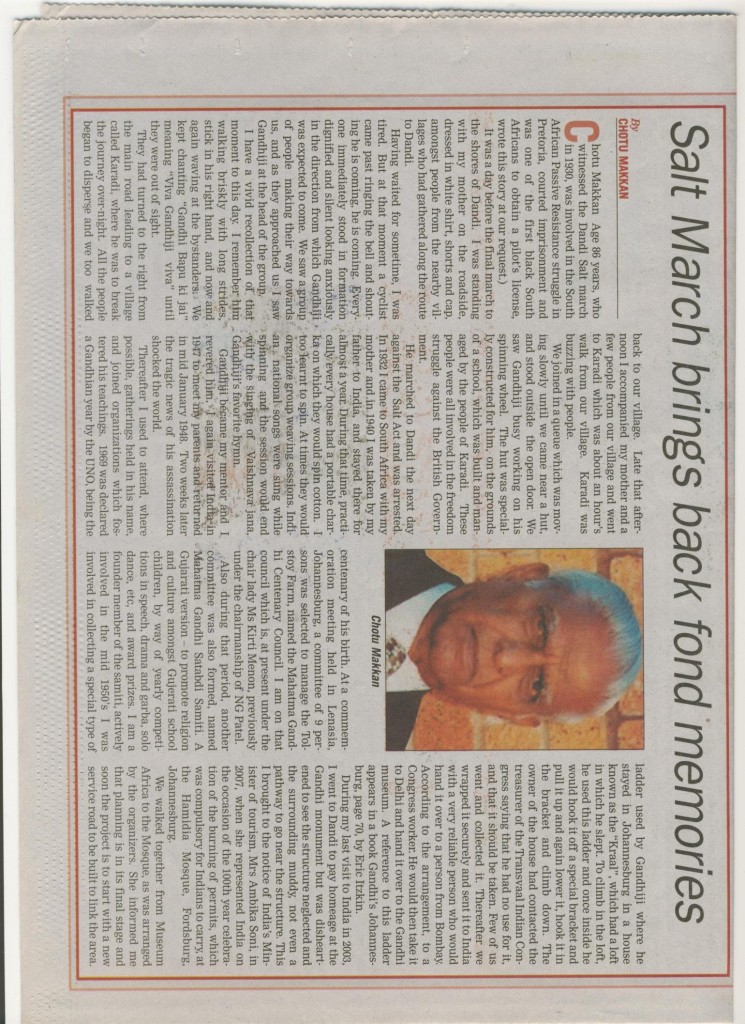
_______________________________________________________________________________________________
Tolstoy Farm
I am of the opinion that the Group Areas Act which was enforced on the Indian people during the Nationalist rule was a blessing. The various communities were allocated separate areas in which they became owners of their houses and accordingly, they developed culturally, socially, and religiously.
They built their temples, churches and mosques. They also built community halls, and vernacular schools, together with other amenities. Lenasia was such an area, declared an Indian township, (just 5km to Tolstoy Farm) for Indian people to move to from Johannesburg, and surrounding areas. But had Lenasia not come into being, I feel that Tolstoy Farm would have been another of Gandhi’s abode.
The Mahatma Gandhi Centenary Council was formed in 1969, during the centenary of Gandhi’s birth. The year also declared as the Gandhian year by the (UNO) United Nations Organisation.
The purpose of the committee was to develop and maintain Tolstoy farm. There was a house, which was used as a Ashram during Gandhiji’s confrontation with the General Smuts government. The house was later occupied by a white family.
Just during that time “The Star” newspaper dated 26 June 1969, in its main article gave a vivid description of the farm, with a coloured artist impression of the house and surrounding, with Gandhi in white Indian dressing in his typical laughing pose, under the heading “City was a cradle of his Philosophy” his epic journey to mahatma hood.
In the beginning of the 80’s the committee embarked on a fund raising drive and banks, business houses and individuals were approached and almost R200.000 was collected. The occupants of the house were requested to vacate, which they did. Thereafter, renovation began, and was completed in 1982, originality was maintained as far as possible. The front room on the eastern side was fitted with library shelves.
The first occupants were Jairam Bhana and his wife. They were approached by the committee members to occupy the house, so that it could be looked after. He started music classes, and the area became lively, but after almost 3years they went back to Pretoria.
There after an African caretaker was employed on weekly wages, but after sometime he also left. It became a matter of concern for the committee and the only alternative was to securely lock the house and the gates.
But in 1996 the entire house was vandalized. Every item was removed including the iron roof. They had gained entrance from the back of the house by cutting the wire fence, and later the 7 metre high fence around the house, two big gates, and all the iron poles (about 50) supporting the fence were removed leaving only the damaged walls of the house (an unpleasant site). These were not ordinary thieves; they had proper tools and transport to do the job. The place was left that way for some time.
Than in 1997 the committee was informed that the Prime Minister of India Shri Inder Kumar Gujral will be visiting the farm, during his official visit to South Africa.
A few members of the committee got together and decided to erect a plinth on the existing foundation of the house, as was suggested by the contractor. Shri Gujral’s visit was a memorable one and he was presented with a gift of an African sculptor.
After that things was normal for some time until one day we saw a heap of sand and stone on the plinth. On inspection it was noticed that a tunnel had been dug up from the top, which was retiled and plastered. A few weeks later it was again dug up in the same way but on the opposite side and that too was patched up.
We later learnt that those people had a notion that there were Kruger Coins buried somewhere in the plinth, and having found nothing from the top, they decided to dig from the side by removing the granite slab, on which a short history of the farm was inscribed next to the front of the steps which was fixed and the slab was left lying on the ground as it was too heavy for them to take away.
In 2001, the Hindu Youths of South Africa invited Shri Morari Bapu, a person who is highly respected and sought after to hear him giving religious discourses and is an ardent admirer of Gandhi. He was very disheartened at the condition of the area, after me giving him a brief history. I showed him some photos including the initial renovation which impressed him and thereafter he announced a donation of Rs100, 000 rupees (about R18, 000. 00) and also informed me that if finance were required I should contact Shri Mahesh Kothari, a person who had accompanied him so that he would be able to assist. At the last election of the Centenary Council held in 2003, Ms Kirti Menon (of the Gandhi Family was elected as President). Soon thereafter it was decide to re-develop Tolstoy Farm and for that a qualified Architect and Quantity Surveyor of the Ahimsa Consulting Company was appointed.
They were made aware of the alterations to the original house with photos and its destruction, and a brief outline on how it can be re-developed befitting Gandhi’s Legacy.
After having surveyed the area and its surroundings they presented a comprehensive report with drawings of suggested structures and a break-down of the estimated cost of over R5 million. They also brought to the notice of the Committee, that according to the Mining Explosive Act we are not allowed to use the present road leading to the farm.
A suggestion for an alternate road was made, which would be about 1km further up from the present turn off (which could also cost approximately, R5 million). Somehow that project stalled although the Tourist Department was casually approached to fund the road, as it will also be used by Tourists, when visiting the farm as it will be part of the Gandhi Heritage Trial. Neither side pursued the matter, and as time went by the security of any structure we put up with the escalating crime, became a matter of concern.
Also during that period the Johannesburg City Council decided to rename the Vanderbijl Square, to Gandhi Square and later erected a statue of Gandhi in a legal Robe worn by attorneys with a law book in one hand, and on each side of the pedestal a brief history is inscribed, and two quotes of Gandhi. The unveiling was held on the 2nd October 2003, being Gandhi’s birth Anniversary. The unveiling Ceremony was a grand affair, performed by His Worship the mayor.
The City of Johannesburg considered itself lucky to count among its assets a number of sites linked to Mahatma Gandhi during the time he had spent in the city. It has recognized the potential that exists to develop a “Gandhi Heritage Trail” that links these sites into a Heritage Tourism Product and has identified the following places to be included:
1.A Gandhi Room at the Constitution Hill.
2.The Gandhi Exhibition at the Museum Africa
3.Gandhi’s Trouville House
4.The Kraal – House in the Orchards
5.Gandhi Square
6.The Hindu Crematorium – Brixton
7.Tolstoy Farm.
Tolstoy Farm (1910-2010)
The centenary of the farm was celebrated on the 30th of May 2010, which was jointly organized by:
1.The Gandhi Centenary council
2.The 1860 Legacy Foundation
3.The Indian Consulate
4.The Gandhi remembrance organist ion
Amongst those present to grace the occasion were:
1.Ela Gandhi – Gandhi’s granddaughter
2.Jody Kollapen – Judge of the Supreme Court
3.Vikram Doraiswami – India’s Consul General
4.Charles Kallenbach – (And his family members) Nephew of the late, Mr. Hermann Kallenbach who gave the farm to Gandhi.
Each one of them spoke on the Solomn occasion appreciating the efforts of the Gandhi (entering) Council in maintaining the farm realizing the remoteness of the area and therefore the security risks.
Thereafter Mrs. Kirti Menon, (Great Granddaughter of Gandhi), and the chairlady of the Council, gave a broad outline of the situation as it stands.
She thanked Mr. Charles Kallenbach and his family members for their presence and her aunt Ela Gandhi who had travelled from Durban. To Mr. Jody Kollapen, and Mr. Vikram Doraiswami for their participation and commitments and lastly the Public for their presence which made the celebrations noteworthy.
Summary of Events
1910 – Hermann Kallenbach – gave the farm to Gandhi, to be used for Satyagrahis.
1913 – Gandhi moved to Durban.
1914 – Gandhi departed to India.
1934 – Farm was transferred (under Deed of Transfer) to Anglo Vaal Brick and Tile
1969 – The Mahatma Gandhi Centenary Council was formed at the celebration of his birth Anniversary.
1974 – Farm was transferred to M.G.C Council by the owners (under Deed of Donation).
1982 – Original house was entirely renovated with 7 feet high wire fence enclosure for security.
1996 – House was completely vandalised, together with the fence.
1997 – Plinth was constructed on its foundation before the arrival of the Prime Minister of India, Shri Inder Kumar Gujral. A sculpture in wood was presented to him.
1999 – An Official visited by the Vice President of India, Shri Krishna Kant, with his wife.
2010- Hundred year of the farm was celebrated on the 30th May, in a dignified atmosphere. Amongst more than 100 persons present were: – Ela Gandhi – (Grand Daughter of Gandhi), Vikram Doraiswamy (Consul General), Family members of Hermann Kallenbach, Jody Kollapen, chairperson of the 1860 legacy foundation, etc.
2010 – A meeting under the auspices of various organisations, including the Gandhi Centenary Council, was convened on the 9th October, at the farm, to discuss its future.
_____________________________________________________________________________________________________
Transvaal Hindu Seva Samaj (My Involvement)
In early 1956, I had moved from Springs, to Johannesburg – Fordsburg, 49 Park Road.
One Sunday afternoon I accompanied a friend to a meeting of the Samaj, held in Gandhi Hall. There I was introduced to some of the members, and as such we came to know each other, and from there our friendship developed.
Thereafter, I started attending these meetings regularly, with the result I came to know many persons and was well accepted, which culminated in me being elected as a member of the 65- member general committee. I must mention here that my name was proposed by Mr. P. Brijla, and seconded by Mr. N Parbhoo, who were also prominent members in our society.
At the next elections held in 1958, I was elected to the library committee, comprising of 7 members. The library was situated in a corner room attached to the school classrooms, adjourning the main hall, which was built in 1940 and, as a remembrance was named Gandhi hall in appreciation to Gandhiji for his non-violence struggle against the unjust laws.
In 1961 I was elected to the Gandhi Bharat Vidyalaya school committee until 1978, but after serving for 17 years I had to resign because of my differences with the school inspector.
During the mid 60s the Samaj started a private English school, from Std 5 to matric. It was professionally administered with qualified teachers. After 3 years we were forced to close down, as it was illegal under the Group Areas Act. I served on it from the start to the end, as the secretary of that committee.
Similarly, in accordance with the Group Areas Act, our Gandhi Hall to was in a white area, and as such our occupation was illegal. Therefore, we were approached time and again to dispose of it and that only whites could own it. We also offered it to the Group Areas Board to take it over, but they were not interested.
This left us with no option but to put it for sale. Three persons of the Samaj were entrusted to negotiate the sale.
Eventually, the deal was concluded with the Protea Assurance Co. for a sum of R1.250-000 it was considered to be a good price under the circumstances. On 21st March 1982 at a final function held in the hall, as one of the speakers, I paid a farewell tribute to the Hall in my own way highlighting its uses, its importance in the lives of specially the Hindu community with regretfullness.
During that period while on a look out for alternate premises, the Mayfair Recreation Hall was offered to one of our Trustees. The structure was suitable for our needs, with some renovations to be done. And against some obstacles, because of opposition within Samaj committee members the deal was negotiated for just over R300,000.00
Building of the Hall: During the period 1978 to 1984 the Samaj was buzzing with various activities, as the general committee had agreed to go ahead with the building of the hall, and although there were certain members who felt that because of the escalation of building costs, we should scale down on the plans.
But the majority of the member’s opinion was that we should go ahead according to the plan submitted by our architect, which was duly passed by the relevant government departments.
Before the nomination of the architect – Messrs Daniel Smit and Partners a planning committee was formed, and I was nominated as its secretary. Thereafter, the same committee was converted as the building committee, which functioned up until the hall was completed. The official opening was delayed for some time and eventually it was officially opened by Nelson Mandela in 1992.
Re-naming of the Hall: – Although it was taken for granted that the hall will be named as Gandhi Hall, the ladies committee had decided that it be named as Mahatma Gandhi Hall, and without any discussion it was proposed at a committee meeting even though the name issue was not on the agenda. The members present did not bother – in fact, they were indifferent or just not interested. I raised my objection against the change, and forwarded my reasons as to why Mahatma was not suitable for our hall, and named few similar places in India, which did not have Mahatma on it.
Having opposed the motion, I requested that a special general meeting be called, to discuss the name, because it will give other members some time to decide and to come up with suggestions.
My request was not entertained, and without any permission from the committee, the Mahatma Gandhi Hall in heavy brass letters was put up at roof level, as if it was a warehouse, a factory, or an air terminal which greatly pained me.
But as destiny had so wielded that in 1995 I became the 15th president of the Samaj – against four other nominations, a position I had all along aspired for, not because of name and fame, but because the Samaj was close to my heart, as it is the premier body of all Gujarati Hindus, and I was proud to have an opportunity to be associated with it.
And during my six years as president, I endeavoured to serve it with sincere dedication. In the beginning, with the approval of the hall management committee, I embarked on the renovations, alterations, addition, and also on painting the entire outer walls of the hall.
It was during that time that while painting the front of the hall the name in heavy bronze had to be removed. They was so securely fixed that it was difficult for the painters to remove it. After the renovations was completed, the hall had a different appearance.
After some time and with the approval of the management committee, the name Gandhi Hall was put up on the front of the hall above the main entrance (on the space which was meant for it, and it), changed the whole image of the entrance.
This gave me inner joy and satisfaction. The other major items I had embarked upon, were:
1.Fencing of the hall grounds on the west side and entire frontage.
2.Adjustments and reinforcement of the seats in the hall.
3.Gandhi’s statue in the foyer enclosed in a glass case.
4.Repaving of the main driveway leading to the hall entrance and many other items which needed attention.
The members appreciated the efforts and there were no questions as to the costs.
Lastly, at an election meeting held in November 2001, in my farewell address, I thanked the members who had given me the opportunity to serve the Samaj, and for their co-operation and loyalty during my six years as president. Although the majority of the members wanted me to serve another term, I had to decline owing to my ill health at the time.
1.Library Committee: I was elected as its chairperson, and therefore took the initiative to oversee the area which was neglected. It took almost a month to have the place painted, cleaning and dusting all the shelves, and thereafter re-arranging the books.
In the mean time I had arranged to get Indian magazines and a few weekly newspapers from India. And as time went by, it became a meeting place for our elders in the Samaj, on Sundays from 3:00pm to 5:00pm, which also gave me inner joy.
2.Sale of Gandhi Hall (Fox Street). The company which negotiated the deal knew of our predicament, but was sympathetic and did not take advantage of the situation, and the deal was done amicably. Not only that, but as a gesture of goodwill to the memory of Gandhi they put up a copper plaque next to the entrance of their new building which read: Here stood Gandhi Hall – built by the TVL. Hindu Seva Samaj.
____________________________________________________________________________________________________
Swadhyaya
What is Swadhyaya?
In the Bhagavad Gita – under the title epilogue aspirants should try to memorise the 18 chapters by heart. This can be done through daily Swadhyaya (scriptural study).
A quote, from one of the Pujya Dada’s writings that: Swadhyaya work is spiritual in thought, attitude and orientation, it justifies that to “Aspire for divine is to work for it”. This divine work is the spiritual imperative to transform the individual as well as social life. “Only those who see the invisible can see the impossible”.
Swadhyaya is not a cult, nor a creed, neither is it a sect, tradition or an institution. It is not even an organised religion. Swadhyaya is an attitude of mind. It is the right perspective or a vision which enables one to understand the deeper aspects of religion and culture. Swadhyaya literally means “study of the self” – the self or the “I” is the in dwelling sprit underlying the ego, intellect and the mind.
Through Swadhyaya we have to soften our “ego” and gradually merge it in the Lord softening the “ego”, God centred, rather than object centred.
In order to transfom our wishes into god wishes – our will into goodwill – we have to regularly practice swadhyaya, and due to continued sincere practice of swadhyaya the goodwill becomes stable, steadfast and holy. Further, the love for God enhances trust in the divine being. According to the Gita “the holy will” is the product of unattained absolute devotion to god (Bhakti).
In this state, one experiences absolute trust in the power and grace of Gods will. Therefore, Swadhyayees, go from village to village, not because it is the need of the hour, nor because it is their responsibility, but because they believe that by spreading the message of the Vedic way of life is true devotion to God – Bhakti is a social force.
Swadhyayees are not social reformers, nor are they world improvers – “they are the devotees of God. They believe that the brotherhood of man is possible only when we accept the fatherhood of God”.
“Jai Yogeshwar”
“The concept of Swadhyaya is as old as the Vedas. But revered Dada has given a wider connotation to it. He has made it richer in meaning, dynamic and relevant to the whole of humanity, now and forever”.
‘Search for the God within’
The Swadhyaya movement was born Gujarat in 1954. Today this movement has over five million followers and thousands of villagers has been completely transformed by his practice and spiritual philosophy. Pujya Pandurang Shastri Athavale, who died a man of immense learning, who has changed the landscape of India’s villages.
How this movement came to South Africa:
It was in early 1992 when a group of four persons came to South Africa from India. They visited Durban before they met a few of us in Johannesburg, and Pretoria.
The purpose of their visit was to explore the possibility of starting the Swadhyaya movement in this country. Two from the group contacted Rajnikant Master (who had been recommended by a prominent person in our community), who arranged with them that he would contact a few interested persons so that we could get together one Saturday at the Laxmi Narayan Temple.
Accordingly, eight of us met and after mutual introductions they gave us a preview of their visit, and also mentioned that such visits will in future follow at regular intervals by other groups. We were then instructed on the procedure to follow. Thereafter we assured them that we would meet every Saturday at the temple from 05:00 – 06:00 pm to carry on the activities. We managed for about three months, and thereafter discontinued, owing to poor turnout.
Thereafter, as they had mentioned that such visits by Swadhyayees will take place at regular intervals, which is known as Bhakti-Ferri (devotional visits). Accordingly, in February 1994, one Sunday morning at about 11:00am, I received a phone call from Shri Chandrakant, a priest of the Rameshwar Mandir, informing me that there are about 30 to 35 Swadhyayees from India and East Africa, and there are looking for a place to stay.
He asked me to come to the Mandir so that we could arrange something. The Mandir is only two streets down the road and I went over and saw men and women walking about in the ground. There baggage and belongings was lined against a wall while some of them had gone visiting nearby houses to enquire about accommodation and others went out to looking for primus stoves so that they could warm the food that they had brought with them.
The area looked like a refugee camp as the priest came over to me, worried regarding accommodation. He offered to put up four persons in the Mandir’s guest rooms. I asked who is the main person whom I could talk to and get some information. He said the person’s name is Shri Ramdas Gandhi, an advocate from Bombay but he, too, had gone out looking for accommodation.
Just then I heard that Rukhiben, who was phoned by a woman who knew her well, had come over. She was told about the plight of these people and felt that she should offer them to come over to her house and went home to ask permission from her husband. The husband, Shri Dayabhai agreed, and they both came by car. We met and discussed the situation together and thereafter informed the visitors to load their belongings in our two cars, and everyone walked to the house with whatever parcels they could carry. The house consisted of four bedrooms, a large lounge, two toilets and a bathroom.
Since then the house became a headquarter for Swadhyaya movement. Thereafter, many came and enjoyed the hospitality of Dayabhai and Rukhiben.
When I went over again they were sitting and discussing. Shantilalbhai and Sureshbhai with few others had come from East Africa (Kenya: Nairobi) is the headquarters for Africa and Sureshbhai handles and manages the distribution of books, audio and video cassettes etc.
I sat next to Ramdasbhai as he started explaining me the purpose of their visit. He mentioned that as Swadhyaya Pariwar they have come to do Bhakti-Ferri, it entails visiting houses, meeting people, introducing ourselves, discuss matters of interest and if they are eager to know about Swadhyaya, we give them simple explanations and answer questions, if any.
He also mentioned that the head of the movement is “Pandurang Shastri Athavale” affectionately referred to as “Pujya Dada”, who started the movement in 1954, and he (Ramdasbhai) was one of the group of 19 persons who had accompanied Pujya Dada on their initial Bhav-Ferri in nearby villages.
He gave me some detail of Shri Dashratbhai, who is also very long with the movement and who previously came on the same mission and stayed with Kantaben Vinod in Daxina. He had earlier phoned Kantaben and she came over to meet the group. She then offered to take two couples to her house and they would do their Bhakti-Ferri in that area.
Dashratbhai also had contacts in Pretoria and there,too, he was told to come over and to bring two couples, so that Pretoria would be covered by their Bhakti-Ferri.
Soon thereafter arrangement was made for four persons to go to Mayfair and that they would cover that area. And the rest of the group would stay at Rukhibens house and cover some of the extensions in Lenasia, and in no time things got sorted out, and my predicament regarding the accommodation was over. Thinking of that situation today, I can without any hesitation attribute that, to the grace of our Pujya Dada.
In Lenasia they formed three groups so that more houses could be visited in various extensions and in the evenings all met and discussed their experiences, and also planned for the next day.
One day, after enquiring if I was at home, Sureshbhai came over with a box containing video and audio cassettes, few books, and other printed matters. He told me that Ramdasbhai, Shantilalbhai and he had chosen me to manage the Swadhyaya movement in South Africa, and that all the Kendra’s will be under my supervision. I was surprised and concerned, but he assured me that while he is here he would guide me as to how the video tapes must be distributed. He made me aware of the spiritual significance of the material he has given me.
A few days later Ramdasbhai, Shantilalbhai, Sureshbhai and myself, went to meet Chandrakantbhai the priest, to ask him permission to use the small Mandir Hall for a meeting. He readily agreed and also to assist wherever possible. The meeting was scheduled for a Friday and we went out inviting people we knew to attend the meeting. The turnout was encouraging.
After the opening talk by Ramdasbhai, Sureshbhai gave details as to how the Kendra’s will be linked with Nairobi, also how the different centres in Africa are managed, and thereafter informed those present that Chotubhai (myself) will be managing the affairs of the Swadhyaya movement in South Africa.
He also mentioned that they have decided after few days of Bhakti-Ferri, that Daxina, Mayfair, and Pretoria, each will have a Kendra together with Lenasia. And without our knowledge they had purchased four TV’s and videos, one for each Kendra. And that is how the Swadhyaya movement started in South Africa, and it’s started functioning reasonably well as there was understanding and cooperation.
A year or so later the same group but in smaller numbers came over and this time our respected “Didi” followed the group a few days later. Her visit was to get a first hand information of the Kendra’s and meet with Swadhyayees, and also to see our country.
We arranged a welcome meeting in her honour in Gandhi Hall. It was well organised and the Consulate General of India, Mr S Tayal was also invited as a VIP guest. I was accorded the privilege to chair the proceedings. After the welcome address Ramdasbhai introduced respected Didi, followed by a speech by Mr S Tayal and few others, thereafter an interesting discourse by Didi and the meeting concluded with a vote of thanks. My inner feeling is that “I was destined to play a meaningful role in the Swadhyaya movement in South Africa.
_________________________________________________________________________________________________
Rameshwar Mahadev Mandir – Lenasia
It was during mid June 1988 that the above Mandir was officially opened. It is situated in a very projecting position i.e.:
Frontage- (East), on Willow Street.
Right side – (North), on Rose Avenue. (Main Road)
Left side- (South), on Narina Avenue.
Main Dome- (West), Rear End.
A very elegant, yet a modest structure
The land on which the Mandir stands was initially allocated, according to the Group Areas Act to the Divine Life Society, (S.A), and was later transferred to the Mandir committee, of which most of the members were of the Divine Life Society, and its activities were administered over the years from a building in Park Road, Fordsburg until 1970. (That was the information I was given).
Soon after the legal procedures of land transfer was finalised, the Mandir committee called a meeting, at which selected persons were invited, and a decision taken to build a Mandir, and that the architectural design to be in conformity with the Mandir in India.
The committee was broadened by taking in extra selected persons, who would assist the committee in raising funds for the construction of the Mandir.
Prior to this, the initial committee had built a Mandir, on the same land, on one side of the area, a simple wood and iron structure, modestly planned, which met the needs during that period, in which all the normal activities were carrying on.
It was in this Mandir that I started attending every Saturday evenings for aarti and the recitals of Hanuman Chalisa, with my friend Shri Bhulabhai, and Shri Bhagwanjee, although I have no recollection of the year I started, it could be in the mid 70’s.
This Mandir, now known as the (Small Mandir) has various Murtis, for special prayers and ceremonies, in a fair sized enclosure partitioned from the hall which is utilized for multipurpose activities such as: yoga classes, music and art of living classes, Swanhyaya Kendra etc.
As an outsider, I was not aware of the activities taking place pertaining to the Mandir, besides that Shri Chotubahi Govind was at the helm of affairs.
This I noticed during the foundation laying ceremony in which only certain persons took part in performing the rituals. The entire procedure was conducted by Shri Chandrekant Sukhla, a priest from India who was appointed by the committee to manage the Mandir.
The person who was responsible for the administration of the Mandir and the complex as a whole, in consultation of the committee is Shri GirishBhai Sukhla. He had replaced Shri Chandrakant Sukhla, who had decided to settle in America. This was towards the late 90’s and a year later the committee decided to recall Shri Atulbhai Sukhla, who was selected by them about two years earlier, but after a short stay returned to India.(reason unknown).
Soon after the construction of the Mandir was completed, which turned out to be an impressive structure the dates for the official opening was announced and advertised for mid June, 1988. Invitations were sent out, locally and overseas.
Pujya Shri Morari Bapu from India was especially invited to honour the occasion, by his revered presence. He is a renowned (kathakar), a person who renders, discourses on Gita, in Gujarati. (A devout admirer of Gandhi).
After his arrival, he organised a (pothi yatra), a procession around few blocks near the Mandir, with the Gita placed on a pedestal in an open colorfully decorated vehicle.
The Murtis had arrived from India according to the order placed, and were displayed in the hall of the small Mandir. But the crate containing the “Shiv- ling” was placed in the store- room. It is believed that in a Shiv Mandir, the entry of the Shiv-Ling, has to be through the roof top, and not trough any opening on ground level.
A day before the Shiv-Ling was to be lowered in the Mandhir from an opening at the base of the main dome, the crate was carefully opened at the top in the presence of some committee members, who were informed by the sender that in the crate they will find a statuette of Lord Ganesha, which was placed in the crate, so as to protect the Shiv-Ling on its Journey.
I was present watching the opening of the crate, unaware of the statuette story, and as soon as the crate was opened, a trustee of the Mandir, Shri Tribhuvanbahi started removing the grass packing, pushing his hands in all sides of the crate over and over again, but was unsuccessful in locating the statuette. After a while it was decided to temporary close the top of the crate, as the by-standers felt that the packer may have missed putting it in. (I was told the story of the statuette, by the same person who was looking for it.)
The next day at about eleven o’ clock the Shiv-Ling was to be lowered in the Mandir area where it would be mounted on a special pedestal. There were many people who had gathered to witness the spectacle. The crane arrangement was made with the fire department who were present.
But just as the proceeding was abouth to start, Shri Bhulabhai Chhita, stood on a table, and announced that, he would like to inform all those who have gathered to witness the consecration ceremony that there is an amount of R700.000.00 over draft owing to the bank, which is a debt over the Mandir, and therefore how could we enter Bhagwan (God) in the Mandir that has a liability.
This debt must be wiped out before the Shiv-Ling is lowered and appealed to those present to donate freely by way of pledging your amounts also stressing that this is an opportunity which has come our way to fulfill our devotional obligation and should therefore consider ourselves blessed.
It was a thought provoking plea which touched the hearts of every one and with the divines blessings the required target was reached and every one were jubilant. Thereafter, the go ahead was given and the procedure began with the firemen securing the crate to the crane before it began, positioning it at the opening, after which it was carefully lowered through the opening in the Mandir near the pedestal.
Thereafter the members started dismantling the crate and while the grass packing was removed, the statuette came in the hands of the same trustee who had searched for it the previous day. He held it with his fingers of both hands and arms stretched high so that all could see it. He was ecstatic and started dancing holding the statuette.
Everyone present were over joyed, chanting praise to the deity “Ganapati” (Personally to me this incident was nothing short of a “Miracle”) because only after the Shiv-Ling was safely placed in the Mandir, it made its appearance.
It took some time before the area was cleaned and the priest started performing the final ceremony. The Shiv-Ling was gently placed on its pedestal permanently, with continuous chanting of mantras (Spiritual verses).
This was followed by the ceremonial bath of the Shiv-Ling , by pouring milk and water on it, with every one present taking their turn, after which it was decorated with flowers and garlands.
Soon thereafter, the priest was ready with the aarti, and all those present were fortunate to partake in the first aarti I was standing next to a pillar. After the aarti, the tray was taken to each and everyone, for them to bow in humble salutation, and take its blessings offer a coin as a gift (own wish, not compulsory) after that (Prasad) distribution of sweet meats and fruits.
Finally, the trustee of the Mandir, Shri Chotubhai Govind spoke on behalf of its members thanking those present for their contribution and participation in the opening of the Mandir, and requested them to take full advantage of the activities by their presence, specially at all the religious occasions and other celebrations. Also the times of the daily aarti was announced by the priest as follows: Mornings at 6-00 am- Evenings at 7-00 pm.
I decided to attend the evening aarti and sat next to the pillar at which I stood during the first aarti, and from there on daily.
Today as we enter the year 2011 it is 23 years, that I have been attending the Mandir daily sitting at the same place, and those who attend regularly for the evening aarti, do not take up my place.
Also I must mention that one Friday in Nov, 2007, I was the only person present for the evening aarti, with Shri Atulbhai the priest (A rare incident) which may never occur again.
As a regular attendee of most of the activities, I must mention that:
1.The Mandir is exceptionally managed as far as its daily morning and evening prayers, and special religious occasions are celebrated.
2.The maintenance of the Mandir and its surroundings, its gardens, its large area covered in lawn, on which outdoor activities are held is superb.
3.Celebrations of occasions such as:
a)Diwali and New Year
b)Navrati and Holi
c)Maha Shiv Ratri
d)Mandir Anniversary. (Yearly) and….
e)Various other notable events.
Furthermore, the Mandir is well decorated with every religious murtis, according to the various events and has a pleasant atmosphere which I am proud to have been associated with.
Finally, with the grace and blessings of the almighty Shri Rameshwar Dada, I am eagerly looking forward to joyfully partake in its 25th anniversary celebrations due in 2013, which would to me, be the culmination of having been compensated for my sincere endeavors.
_____________________________________________________________________________________________
